2. 安徽省矿产资源与矿山环境工程技术研究中心, 合肥 230009;
3. 东华理工大学地球科学学院, 南昌 330013;
4. 安徽省公益性地质调查管理中心, 合肥 230091
2. Anhui Province Engineering Research Center for Mineral Resources and Mine Environments, Hefei 230009, China;
3. School of Earth Sciences, East China University of Technology, Nanchang 330013, China;
4. Public Geological Survey Management Center of Anhui Province, Hefei 230091, China
长江中下游Cu-Fe-Au多金属成矿带是我国重要的成矿带之一(常印佛等, 1991; 唐永成等, 1998; 毛景文等, 2004; Mao et al., 2011; 周涛发等, 2017),主要由7个传统的大型矿集区(从西到东分别为鄂东南、九瑞、安庆-贵池、庐枞、铜陵、宁芜和宁镇矿集区)以及近年来新发现的宣城矿集区组成,在成矿带内对成矿地质条件、成矿规律和成矿模式等方面的研究已经十分深入,取得了丰富的成果(常印佛等, 1991, 2017; 周涛发, 2008, 2017; 袁峰等, 2008, 2010, 2012; Pirajno and Zhou, 2015; Nie et al., 2017; 刘光贤等, 2017; Sun et al., 2017; Liu et al., 2018a, b)。
随着近年来找矿勘查工作不断取得突破,先后在宣城矿集区发现了茶亭铜金矿、荞麦山铜钨矿、刘家山硫铁矿、麻姑山铜钼矿等多个矿床,其中茶亭矿床已经达到大型规模。这些矿床主要为斑岩-矽卡岩型热液矿床。矿床的形成与中生代燕山晚期中酸性侵入岩密切相关,矿体多产于侵入体与石炭系中-上统灰岩、二叠系栖霞组灰岩接触带内。前人对宣城矿集区进行的研究较少,目前仅有茶亭斑岩型铜金矿床资料发表(江峰, 2017; 江峰等, 2017; 肖庆玲等, 2018; Xiao et al., 2019),其他矿床相关的矿床学、岩石学相关研究未见报道,成矿物质来源、成矿机理、成矿岩体源区及深部演化过程亟待研究。
暗色微粒包体广泛分布于钙碱性花岗质岩体中,其成因主要有四种, 分别为:围岩捕掳体(Maas et al., 1997; 彭卓伦等, 2011)、源岩残留体(Chappell and White, 1991; White et al., 1999)、同源岩浆的析离体(Dahlquist, 2002; Donaire et al., 2005; 陈卫锋等, 2007)以及岩浆混合形成的暗色包体(Vernon, 1984; Didier and Barbarin, 1991; Neves and Vauchez, 1995; Perugini et al., 2003; 徐夕生等, 2004; Barbarin, 2005; 朱金初等, 2006; Jiang et al., 2009; Zhao et al., 2010, 2012)等成因。确定暗色包体的成因及源区对了解矿区成矿岩体的源区、成岩机制和岩浆演化过程及其对矿床形成具有重要意义。
荞麦山矿床是宣城矿集区内典型的矽卡岩矿床,矿床的形成与早白垩世侵入体密切相关(刘晓明和段留安, 2015),侵入体岩性为花岗闪长斑岩,在侵入体中发育有较多暗色包体。为研究暗色包体和寄主岩石成因、岩浆演化过程对成矿的意义提供了良好的研究对象。我们对荞麦山矿区的侵入体及其中的暗色包体进行了LA-ICP-MS锆石U-Pb同位素年龄、全岩及矿物地球化学、锆石原位Hf-O同位素、全岩Sr-Nd同位素组成测定等工作,旨在通过其元素地球化学及同位素地球化学特征探讨该矿床成矿岩体的岩浆源区、包体成因、侵入岩形成机制及成矿意义。
1 区域地质背景及矿床地质特征 1.1 区域地质背景长江中下游成矿带位于扬子板块的北缘,大别造山带前陆的长江断裂带内,是我国重要的Cu-Fe-Au多金属成矿带之一(常印佛等, 1991; 唐永成等, 1998; 周涛发等, 2008, 2017)。成矿带形成经历了中生代转换复合的构造体制、强烈的壳幔相互作用等复杂的大陆动力学过程,具有爆发式的多阶段岩浆活动、大规模的铜铁金多金属成矿作用和多类型的复杂成矿系统演化,以及深部找矿潜力巨大等特点(唐永成等, 1998; 周涛发等, 2008, 2017)。矿床以矿集区的形式沿江呈近东西-北东向弧形展布,共发育各类Cu、Fe、Au矿床约200余处(Mao et al., 2006; 2011; Zhou et al., 2011)。
宣城矿集区位于长江中下游成矿带的南东侧,在铜陵矿集区以东、宁芜矿集区以南(图 1)。宣城矿集区地层主要分为志留系-泥盆系的海相碎屑岩沉积、石炭系-三叠系中统的海相碳酸盐沉积以及三叠系中统-二叠系的陆相碎屑岩沉积三套沉积建造,其中石炭系中上统黄龙、船山组-二叠系下统栖霞组的碳酸盐岩沉积建造与宣城矿集区内的Cu、S、Pb、Zn、Au等矿床关系密切,是区域内主要的赋矿层位(图 2)。区域内发育一系列北东向的断裂构造以及北西向、北北西向的次级断裂;褶皱构造在区内也较发育,枢纽方向也以北东向为主。此外,区域内的中生代岩浆活动发育,以白垩世高钾钙碱性中酸性侵入岩为主,侵入岩与区内的矿床形成关系密切。区域内矿产资源丰富,主要有Cu、S、Pb、Zn、Au、Mn等金属矿产及石灰岩、大理岩、石墨等非金属矿产资源(刘晓明和段留安, 2015)。

|
图 1 长江中下游成矿带地质图及各矿集区位置图(据常印佛等, 1991; 毛景文等, 2004; Mao et al., 2011; 周涛发等, 2017修改) Fig. 1 Geological map of the Middle-Lower Yangtze River Valley Metallogenic Belt and the location of ore districts (modified after Chang et al., 1991; Mao et al., 2004, 2011; Zhou et al., 2017) |
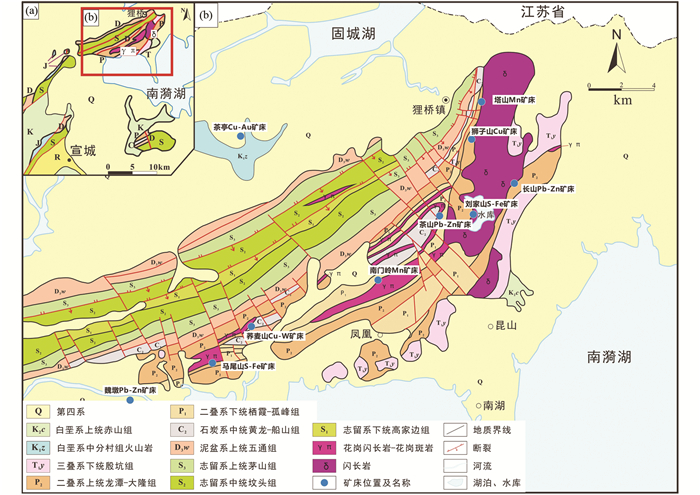
|
图 2 宣城矿集区地质图(据刘晓明和段留安, 2015修改) Fig. 2 Sketch geological map for Xuancheng ore district (modified after Liu and Duan, 2015) |
荞麦山矿床是宣城矿集区内典型的矽卡岩型矿床,位于长山复背斜的次一级连续褶皱构造荞麦山-茶山倒转背斜的南西倾伏端(图 3a);矿床铜金属量约5.9万吨、硫铁矿矿石量约500万吨、钨金属量0.83万吨,为中型矽卡岩矿床(刘晓明和段留安, 2015)。矿区内主要地层为泥盆系五通组砂岩(D3w)、石炭系黄龙-船山组(C2+3)以及第四系地层(Q)。矿体主要赋存与石炭系黄龙船山组与侵入体接触带内(图 3b),钻孔揭示矿区内仅有花岗闪长斑岩侵入体,且侵入体与矿体在空间上关系密切,原石炭系地层大多遭受接触交代或接触热变质作用,形成石榴子石矽卡岩或大理岩,蚀变类型主要有矽卡岩化、蛇纹石化、绿泥石化、大理岩化等;矿化类型主要为磁铁矿化、黄铁矿化、磁黄铁矿化、黄铜矿化、白钨矿化等;矿石类型以块状矿石、脉状-浸染状矿石为主,矿石矿物为黄铜矿、白钨矿、黄铁矿、磁铁矿等,脉石矿物为石英、石榴子石、方解石等。
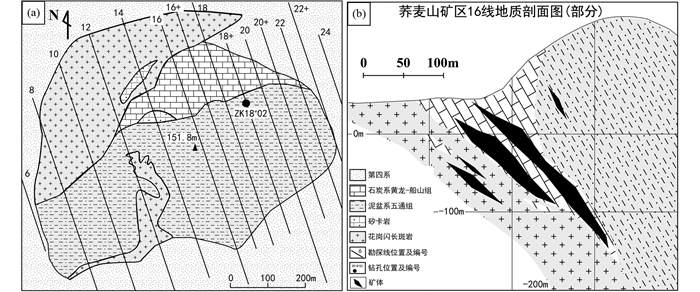
|
图 3 荞麦山矿区地质简图(a)和荞麦山矿床16线地质剖面图(b)(据刘晓明和段留安, 2015修改) Fig. 3 Sketch geological map (a) and No.16 cross-section geological map (b) of Qiaomaishan deposit (modified after Liu and Duan, 2015) |
自侵入体至围岩存在矽卡岩蚀变分带,由于16线石炭系地层较薄,分带不明显,故选择钻孔18+02(钻孔深度:-107~-337m)自上至下展示矽卡岩分带(图 4),顶板为泥盆系五通组石英砂岩,有脉状浸染状黄铁矿化,局部为团块状矿化,同时也有少量磁铁矿化及绢云母化蚀变,石炭系地层多变质为大理岩,局部有矽卡岩脉穿插,矿体主要位于石榴子石矽卡岩带,以块状矿石和脉状矿石为主,黄铜矿黄铁矿白钨矿空间上共生,靠近岩体和围岩接触带主要为蛇纹石化矽卡岩,透辉石较少,岩体主要发生绿泥石化绢云母化蚀变,自围岩向岩体磁铁矿含量增多。
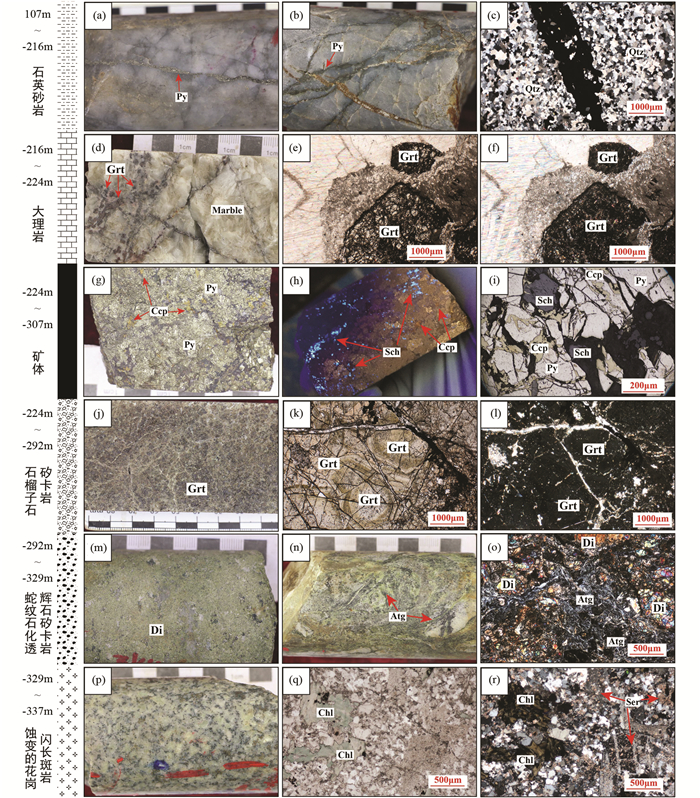
|
图 4 荞麦山矿床矽卡岩蚀变分带 (a-c)石英砂岩中黄铁矿细脉;(d-f)大理岩中石榴子石脉;(g)黄铁矿黄铜矿白钨矿矿石;(h)白钨矿(荧光灯下);(i)黄铁矿黄铜矿白钨矿矿石镜下照片;(j)石榴子石矽卡岩;(k、l)石榴子石矽卡岩镜下特征;(m)透辉石矽卡岩;(n)蛇纹石化透辉石矽卡岩;(o)蛇纹石化透辉石矽卡岩镜下特征;(p)蚀变的花岗闪长斑岩;(q、r)蚀变的花岗闪长斑岩镜下特征. Atg-蛇纹石;Ccp-黄铜矿;Chl-绿泥石;Di-透辉石;Grt-石榴子石;Marble-大理岩;Py-黄铁矿;Qtz-石英;Sch-白钨矿;Ser-绢云母 Fig. 4 Skarn alteration zoning of the Qiaomaishan deposit (a-c) pyrite vein in quartz sandstone; (d-f) garnet vein in marble; (g) pyrite chalcopyrite scheelite ore; (h) scheelite (under the fluorescent lamp); (i) microphotograph of ore; (j) garnet skarn; (k, l) microphotographs of garnet skarn; (m) diopside skarn; (n) serpentinized diopside skarn; (o) microphotograph of serpentinized diopside skarn; (p) altered granodiorite porphyry; (q, r) microphotographs of altered granodiorite porphyry. Atg-antigorite; Ccp-chalcopyrite; Chl-chlorite; Di-diopside; Grt-garnet; Py-pyrite; Qtz-quartz; Sch-scheelite; Ser-sericite |
选取相对远离岩体与围岩接触带区域且受蚀变作用影响较小的岩体样品作为本次研究的对象,暗色包体样品选择长轴大于5cm的暗色包体进行相关测试以避免寄主岩石对样品造成污染。
暗色包体(图 5a-c):在花岗闪长斑岩中暗色包体较为常见,包体与寄主岩石界线截然、并且冷凝边不发育(图 5d, g, j),包体直径变化较大,从几厘米至十几厘米均有,多为浑圆状或椭球状。包体颜色为灰黑色,矿物粒径较细,为半自形-他形粒状结构,镜下鉴定结果显示暗色包体均具有岩浆结构,排除其为围岩捕虏体的可能;另外,暗色包体中的矿物颗粒小,与岩浆早期堆晶体一般具有粗大的矿物颗粒和较好的自形程度特征不一致,因此其为早期堆晶体可能性较低。暗色矿物以角闪石为主,含量较高(~30%),多为自形柱状,黄绿色-绿色;浅色矿物以斜长石为主(40%~50%),粒径大小不等,正交偏光下为灰白色,环带结构不发育(图 5f, i)。还有少量的石英及钾长石(约15%),此外还有少量磁铁矿、锆石、磷灰石等副矿物。
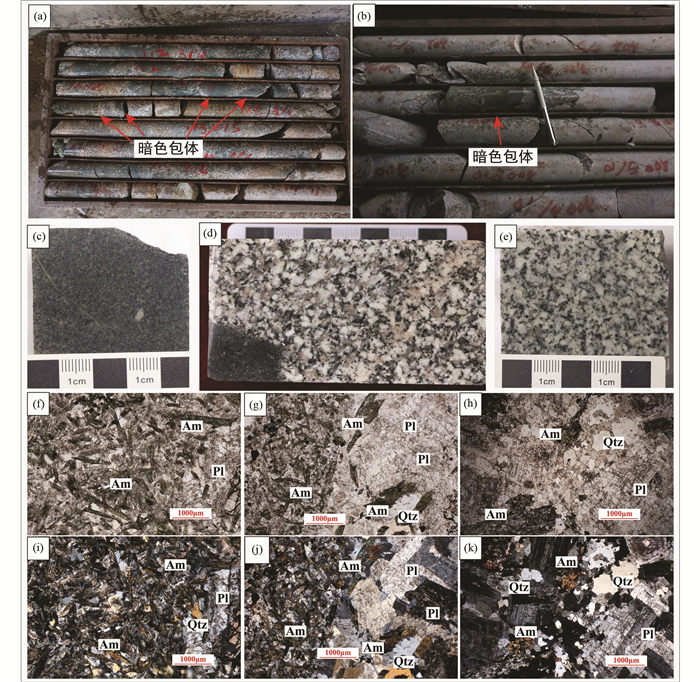
|
图 5 暗色包体产状、典型样品特征及镜下照片 (a、b)岩心中的暗色包体;(c)暗色包体;(d)花岗闪长斑岩中的暗色包体;(e)花岗闪长斑岩;(f、i)暗色包体镜下特征;(g、j)暗色包体与寄主岩石边界镜下照片;(h、k)花岗闪长斑岩镜下照. Am-角闪石;Pl-斜长石 Fig. 5 Mafic microgranular enclaves, typically samples and mico photomicrographs (a, b) MMEs in core; (c) typical MMEs sample; (d) MMEs in granodiorite porphyry; (f, i) microphotographs of MMEs; (g, j) microphotographs of the MMEs and host rock boundary; (h, k) microphotographs of granodiorite porphyry. Am-amphibole; Pl-plagioclase |
花岗闪长斑岩(图 5e):灰白色,块状构造;斑状结构,斑晶主要为斜长石(1~5mm)、石英(0.8~1.6mm)以及少量的钾长石(0.8~2.4mm);主要由斜长石(40%~60%)、石英(15%~25%)、钾长石(5%~10%)、角闪石(10%~20%)、黑云母(5%)以及磁铁矿、锆石、磷灰石等副矿物(~2%)组成;样品有少量浸染状或星点状分布的黄铁矿化。斜长石自形程度较好,正交偏光下为灰白色,聚片双晶发育,斜长石斑晶多具有环带结构;角闪石多为绿色-黄绿色,粒径较小(图 5h, k)。
2.2 分析测试方法 2.2.1 LA-ICP-MS锆石U-Pb同位素定年锆石分选、制靶及阴极发光(CL)照相由廊坊宏信地质勘查技术服务有限公司完成。LA-ICP-MS锆石U-Pb同位素定年测试工作在合肥工业大学资源与环境工程学院矿物原位分析实验室完成。具体过程参见文献(刘光贤等, 2017)。测试前用酒精和稀硝酸(5%)擦拭样品表面,使用激光-电感耦合等离子质谱仪(LA-ICP-MS)完成测试,采用激光器为GEOLAS,激光剥蚀系统波长193nm,工作参数为:剥蚀物质载He为0.6L/min,激光脉冲频率7Hz,剥蚀孔径30μm,剥蚀时间为90s,背景测量时间为25s,脉冲能量密度为10mJ/cm2;测量质谱仪为Agilent 7500,工作参数为:Rf功率1300W,进样深度5.5mm,等离子气体Ar 15L/min,辅助气体Ar 1L/min,补偿气体Ar 0.8~0.9L/min。应用NIST 610玻璃作为元素外标,锆石标样91500进行同位素分馏校正,锆石标样Mud Tank作为同位素监控样,本实验室测定的锆石标样的误差与推荐值一致。数据处理采用中国地质大学(武汉)开发的ICPMSDdata Cal9.9软件完成。普通铅校正采用的Andersen的方法(Andersen and Griffin, 2004),采用Isoplot(2.49版)进行年龄计算及谐和图的绘制(Ludwig, 2001),实验过程中误差为1σ。详细方法参见文献(Liu et al., 2010)。
2.2.2 全岩地球化学分析全岩主、微量元素分析在澳实分析检测(广州)矿物实验室完成。其中主量元素使用ME-XRF06X荧光光谱仪进行X-射线荧光光谱法(XRF)测定,氧化物总量分析误差为1%~3%,大致过程为:称取0.7g样品,然后加入适量硼酸高温熔融呈玻璃片,最后在XRF上用外标法测定氧化物含量。微量元素采用四酸消解法电感耦合等离子质谱仪(ME-MS61)法,稀土元素的测定采用熔融法电感耦合等离子体质谱法(ME-MS81)法。
2.2.3 全岩Sr-Nd、锆石Hf-O同位素分析全岩Sr-Nd同位素组成分析由中国地质大学(武汉)地质过程与矿产资源国家重点实验室完成。样品的化学制备同样采用低本底HNO3+HF混合酸和聚四氟乙烯坩埚加不锈钢外套的溶样弹密闭方法溶解,采用AG50X8阳离子交换树脂和LN-spec(Eichrom公司)特效树脂分别进行元素Sr和Nd的分离与纯化。Sr和Nd同位素比值测量采用Triton Ti (Thermo-Fisher)热电离质谱(TIMS)测量。
锆石原位Hf-O同位素分析在澳大利亚国立大学地球科学中心(RSES)进行。将U-Pb测试后的锆石靶再次打磨抛光后,标注原测试点位点号,O同位素使用高分辨离子探针(型号为SHRIMP Ⅱ)进行测试。详细分析方法参考Ickert et al. (2008)。Hf同位素使用螺旋式HELEX剥蚀系统多接收器等离子体质谱(LA-MC-ICP-MS),由美国Coherent Inc.公司生产的COMPex PRO 102 ArF准分子激光源和美国Agilent公司生产的Agilent 7500a ICP-MS组成。详细测试方法参见Eggins et al. (2005)。测试标样选取91500、FC-1、Mud Tank、QGNG和PLE,同位素数据使用Iolite程序包软件离线处理,处理通用流程参见Paton et al. (2011)。
2.2.4 电子探针分析及矿物元素面扫描分析矿物电子探针(EPMA)分析在合肥工业大学资源与环境工程学院电子探针室完成,仪器型号为JEOL JXA-8230。实验条件为:加速电压15kV,束斑尺寸3μm,探针电流20nA。所有元素的信号采集时间为15s,背景时间为5s,修正方法ZAF,检测限优于100×10-6。
矿物元素面扫描分析在合肥工业大学资源与环境工程学院矿物原位分析实验室完成。激光剥蚀系统为PhotenMachines Analyte HE(其中激光器为相干公司193nm ArF准分子激光器),ICP-MS为Agilent 7900。样品分析前和结束后采集约20s背景信号。扫描待测样品开始和结束时对外标样品(NIST 610)进行约40s的点剥蚀。样品测试时激光参数与标样测试时一致。质谱仪参数设定如下:单个元素扫描时间为10ms,所有元素测试时间控制在0.5s以内。数据分析与成图采用实验室内部设计软件LIMS(基于Matlab设计)完成。整个分析过程中仪器信号漂移、背景扣除等均由软件自动完成。精确含量校正采用内标法完成。相关细节及详细方法参见汪方跃等(2017)。
3 分析结果 3.1 锆石U-Pb定年结果荞麦山花岗闪长斑岩样品中锆石晶型完整,偶见裂纹,以纺锤状为主,一般长150~250μm,宽50~150μm。锆石透明度较高,多为无色。暗色包体中锆石颗粒较花岗闪长岩偏小,一般长100~200μm,宽50~100μm。锆石透明度相对花岗闪长斑岩较低,多为浅黄色。CL图像显示(图 6c, d),暗色包体和寄主花岗闪长斑岩的锆石均发育有很好的振荡环带,为典型的岩浆锆石。花岗闪长斑岩中锆石的Th/U比值在0.77~1.35之间(表 1),暗色包体中锆石的Th/U比值在0.31~2.29之间,均属于岩浆成因锆石范围(Hoskin and Ireland, 2000)。
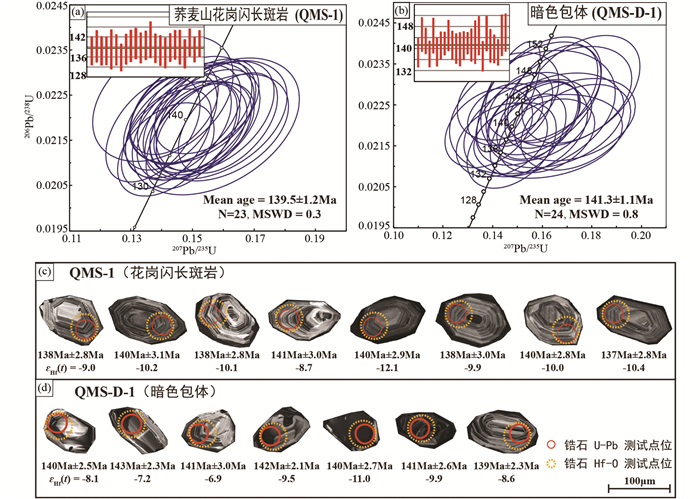
|
图 6 花岗闪长斑岩和暗色包体U-Pb定年结果和谐和图(a、b)及典型锆石CL图像和U-Pb、Hf-O测试点位(c、d) Fig. 6 U-Pb analytical result and concordia diagrams (a, b) and typical zircon cathodoluminescence (CL) images and the spots location of U-Pb, Hf-O analytics (c, d) of MMEs and host rock |
|
|
表 1 宣城荞麦山矿床花岗闪长斑岩及暗色包体锆石U-Pb分析结果 Table 1 Analytical results of zircon U-Pb dating for the granodiorite porphyry and MMEs from Qiaomaishan deposit, Xuancheng ore district |
锆石U-Pb定年结果见表 1(谐和度低于85%的数据点已剔除)。荞麦山矿床的花岗闪长斑岩(寄主岩石)的定年结果为139.5±1.2Ma (MSWD=0.3)(图 6a)。暗色包体定年结果为141.3±1.1Ma (MSWD=0.8)(图 6b)。
3.2 全岩地球化学分析结果荞麦山矿床的花岗闪长斑岩(寄主岩石)及暗色包体的主、微量元素分析结果见表 2。花岗闪长斑岩(寄主岩石)的SiO2含量在63.52%~66.68%,而暗色包体的SiO2含量在53.33%~57.99%,明显比寄主岩石更偏基性,在(K2O+Na2O)-SiO2图解(图 7a)上,包体多落于二长闪长岩区域内,而寄主岩石落于花岗闪长岩区域内。寄主岩石和包体的全碱含量(K2O+Na2O)基本一致(寄主岩石:6.87%~7.50%;包体:6.35%~7.72%),在K2O-SiO2图解中(图 7b),包体与寄主岩石均属于高钾钙碱性系列,但包体的MgO含量及Fe2O3T含量显著高于寄主岩石。包体及寄主岩石的A/CNK值相差不大(包体:0.66~0.78;寄主岩石:0.78~1.01),均为准铝质岩石(图 7c)。在哈克图解中,主要的氧化物如Al2O3、CaO、Fe2O3T、MgO、MnO、TiO2与SiO2含量均呈负相关关系(图 8)。
|
|
表 2 宣城荞麦山花岗闪长斑岩及暗色包体主量元素(wt%)和微量元素(×10-6)分析结果 Table 2 Analytical results of major (wt%) and trace (×10-6) element compositions of granodiorite porphyry and MMEs from the Qiaomaishan deposit, Xuancheng ore district |

|
图 7 暗色包体与寄主岩石的(K2O+Na2O)-SiO2图解(a, 底图据Middlemost, 1994)、K2O-SiO2图解(b, 实线据Peccerillo and Taylor, 1976;虚线据Middlemost, 1985)及A/NK-A/CNK图解(c, 据Maniar and PiccoliI, 1989) Fig. 7 (K2O+Na2O) vs. SiO2 (a, base map after Middlemost, 1994), K2O vs. SiO2 (b, full line according to Peccerillo and Taylor, 1976; imaginary line according to Middlemost, 1985) and A/NK vs. A/CNK (c, base map after Maniar and PiccoliI, 1989) diagrams of MMEs and host rock |
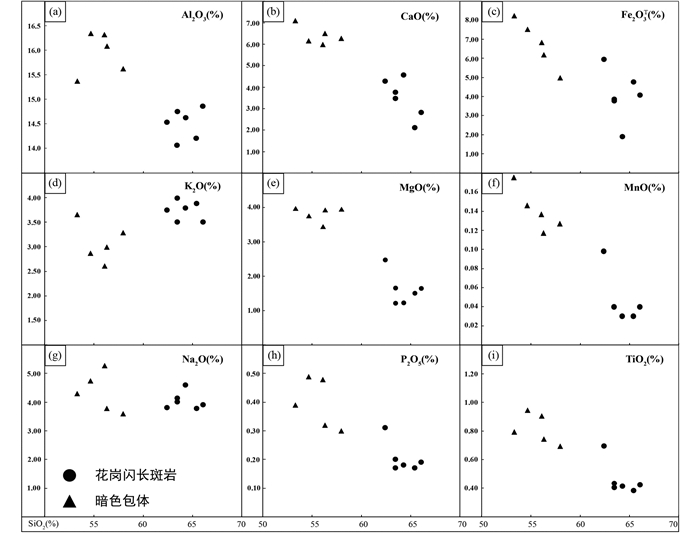
|
图 8 暗色包体与寄主岩石哈克图解 Fig. 8 Haker diagram of MMEs and host rock |
包体与寄主岩石有相似的稀土元素配分模式(图 9a)和微量元素特征(图 9b)。暗示包体和寄主岩石有一定的成因联系。包体与寄主岩石稀土总量基本一致(包体平均值为133×10-6,寄主岩石为127×10-6),稀土元素配分模式均为轻稀土富集型的右倾式配分模式,轻重稀土分馏明显(LREE/HREE:包体为8.85~11.60,寄主岩石为11.7~15.20)。此外,包体与寄主岩石均无明显的Eu异常(包体δEu=0.9~1.0,寄主岩石δEu=0.9~1.1)。寄主岩石与暗色包体均具有富集大离子亲石元素(Rb、Sr、Ba等)、亏损高场强元素(Nb、Ta、Ti等)的特征。
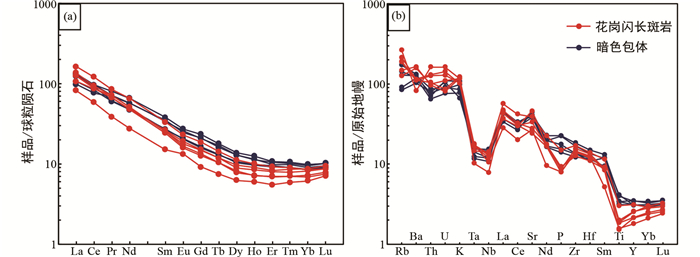
|
图 9 暗色包体、寄主岩石球粒陨石标准化稀土配分模式图(a, 标准化值据Boynton, 1984)与原始地幔标准化微量元素蛛网图(b, 标准化值据Sun and McDonough, 1989) Fig. 9 The chondrite-normalized REE patterns (a, normalization values after Boynton, 1984) and primitive mantle-normalized trace element spider diagrams (b, normalization values after Sun and McDonough, 1989) of MMEs and host rock |
全岩Sr-Nd同位素分析结果见表 3,包体和寄主岩石的(87Sr/86Sr)i值及εNd(t)值均以包体及寄主岩石的加权平均年龄计算。寄主岩石的(87Sr/86Sr)i值为0.7061~0.7064,包体的(87Sr/86Sr)i值为0.7059~0.7069;εNd(t)值寄主岩石为-8.7~-7.7,包体为-9.2~-6.0。包体的Nd模式年龄和Nd两阶段模式年龄相差不大(tDM=1.33~1.69Ga,均值为1.49Ga;t2DM=1.42~1.69Ga,均值1.53Ga),寄主岩石的Nd模式年龄和Nd两阶段模式年龄相差稍大(tDM=1.27~1.42Ga,均值1.35Ga;t2DM=1.54~1.64Ga,均值1.58Ga)。
|
|
表 3 宣城荞麦山花岗闪长斑岩及暗色包体Sr-Nd同位素组成测试结果 Table 3 Analytical results of Sr-Nd isotopic composition of granodiorite porphyry and MMEs from the Qiaomaishan deposit, Xuancheng ore district |
锆石原位Hf-O同位素分析结果见表 4。包体和寄主岩石的εHf(t)值均以包体及寄主岩石的加权平均年龄计算。暗色包体的εHf(t)值分布在-12.7~-5.8之间,寄主岩石的εHf(t)值分布在-12.1~-8.1之间。Hf的两阶段模式年龄方面,寄主岩石的稍大于暗色包体(暗色包体1.74Ga,寄主岩石1.81Ga)。包体的δ18O值分布区间为5.8‰~7.7‰,均值为6.4‰,寄主岩石的为5.6‰~7.4‰,均值为6.5‰,均高于地幔锆石的O同位素比值(5.3‰±0.3‰, Valley et al., 1998, 2005)。
|
|
表 4 宣城荞麦山花岗闪长斑岩及暗色包体锆石Hf-O同位素测试结果 Table 4 Analytical results of zircon Hf-O isotopic of granodiorite porphyry and MMEs from the Qiaomaishan deposit, Xuancheng ore district |
荞麦山花岗闪长斑岩(寄主岩石)中的斜长石斑晶多发育环带结构,本次研究中挑选了两颗环带结构发育,未受绢云母化蚀变影响的斜长石斑晶(图 10a, b)利用电子探针对斜长石环带进行主量元素分析,分析结果见表 5。利用电子探针分析的数据计算了对应点位的斜长石牌号(图 10c, d)。

|
图 10 花岗闪长斑岩中斜长石斑晶电子探针剖面分析(a、b)及对应点位斜长石牌号(c、d) Fig. 10 The EPMA section analytical of plagioclase in granodiorite porphyry (a, b) and the plagioclase number of corresponding analytical spot (c, d) |
|
|
表 5 宣城荞麦山花岗闪长斑岩斜长石电子探针分析测试结果(wt%) Table 5 Analytical results (wt%) of plagioclase of granodiorite porphyry from the Qiaomaishan deposit, Xuancheng ore district |
进行元素面扫描的斜长石在显微镜下显示其具有明显的核幔结构,核部与幔部形态基本一致,核幔交界部位发育有绢云母化蚀变带,核部环带结构不发育,幔部环带清晰(图 11a),元素面扫描结果可见该斜长石具有一个富Ca、Sr(图 11b, c)的核,富Na、Ba、Si(图 11d-f)及富轻稀土(La、Ce)(图 11g, h)的幔。另外,Al、Fe、K、Rb(图 11i-l)含量核幔差异不明显。
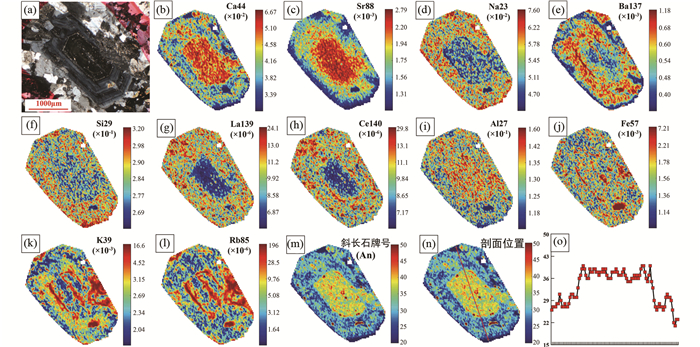
|
图 11 斜长石元素面扫描分析结果 Fig. 11 Elements mapping analysis results of plagioclase |
根据近年来长江中下游成矿带年代学数据(不包括宁镇矿集区)(Sun et al., 2003; Li et al., 2008, 2009, 2014; Xie et al., 2008, 2011a, b, 2012; 陈志洪等, 2011, 2013; 范裕等, 2011; Zhou et al., 2011; 汪晶等, 2014; 段留安等, 2015; Wang et al., 2015; Liu et al., 2016; 王世伟等, 2018)绘制成长江中下游成矿带成岩年龄分布图(图 12),长江中下游成矿带成岩作用在时空上表现出明显的分区性和分带性(周涛发等, 2017)。断隆区(如铜陵矿集区、九瑞矿集区等)的成岩时代在146~135Ma之间,以铜金成矿为主;断凹区(火山岩盆地,如庐枞盆地、宁芜盆地等)的成岩时代为135~126Ma,成矿作用以铁为主;以及与铀、金矿化有关的A型花岗岩集中形成于126~123Ma(范裕等, 2008; 周涛发等, 2008, 2010)。荞麦山矿床成矿花岗闪长斑岩形成于139.6Ma,属于早白垩世岩浆活动,岩体形成年代与铜陵矿集区(145~135Ma; 谢建成, 2008)等断隆区岩浆活动时间一致,属于长江中下游成矿带第一阶段岩浆活动。
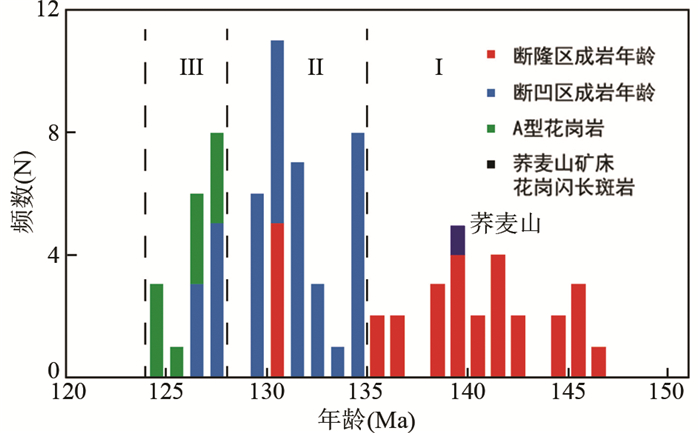
|
图 12 长江中下游成矿带成岩年龄直方图 数据来源:Sun et al., 2003; Li et al., 2008, 2009, 2014; Xie et al., 2008, 2011a, b, 2012; 陈志洪等, 2011; 范裕等, 2011; Zhou et al., 2011; 汪晶等, 2014; 段留安等, 2015; Wang et al., 2015; Liu et al., 2016; 王世伟等, 2018 Fig. 12 Histogram of the diagenetic ages of the Middle and Lower Yangtze River Metallogenic Belt Data sources : Sun et al., 2003; Li et al., 2008, 2009, 2014; Xie et al., 2008, 2011a, b, 2012; Chen et al., 2011; Fan et al., 2011; Zhou et al., 2011; Wang et al., 2014, 2015, 2018; Duan et al., 2015; Liu et al., 2016 |
在(87Sr/86Sr)i-εNd(t)图解(图 13)上,花岗闪长斑岩(寄主岩石)及暗色包体与扬子上、下地壳的Sr-Nd同位素组成差异显著,说明荞麦山花岗闪长斑岩不太可能由上地壳或下地壳直接熔融形成。寄主花岗闪长斑岩的(87Sr/86Sr)i值和εNd(t)值整体比较均一,且与铜陵矿集区中酸性侵入岩分布区较为一致。处于断隆区的铜陵矿集区在地理位置上与宣城矿集区相近(图 1b),且前人已有的研究(谢建成, 2008; 谢建成等, 2012; 徐晓春等, 2012; Guo et al., 2013)表明:底侵的玄武质岩浆(来自富集岩石圈地幔)和来自下地壳的岩浆发生混合是铜陵矿集区中酸性侵入岩浆形成的主要方式。宣城荞麦山矿床成矿岩体形成时代与铜陵矿集区岩浆活动时间吻合,因此铜陵矿集区与宣城矿集区在~140Ma应该处于相同的大地构造背景下,故荞麦山花岗闪长斑岩岩浆源区与铜陵矿集区类似,同样也主要起源于富集岩石圈地幔。但荞麦山花岗闪长斑岩更大的εNd(t)值暗示荞麦山花岗闪长斑岩的源区壳源组分更少。暗色包体的数据相对寄主岩石和铜陵矿集区侵入岩的εNd(t)值更大指示其主要来自于富集岩石圈地幔的部分熔融形成。同时暗色包体的数据点与宁芜矿集区早白垩世火山岩分布区范围一致,而宁芜盆地位于宣城矿集区以北(图 1b),已有研究(王元龙等, 2001; 刘洪等, 2002; Wang et al., 2006; Yan et al., 2008, 2009; Yu et al., 2008; 范裕等, 2010; 侯可军和袁顺达, 2010; Chen et al., 2013; 孙维安等, 2017; Liu et al., 2018b)表明宁芜地区早白垩世火山岩(~130Ma)主要起源于富集岩石圈地幔且受地壳混染影响较小。与暗色包体主要来源于富集岩石圈地幔的结论一致。有两个暗色包体的数据点εNd(t)值更小、(87Sr/86Sr)i=0.7050~0.7064、tDM偏大可能是由于暗色包体所代表的地幔端元岩浆同化混染了部分下地壳古老物质所致。
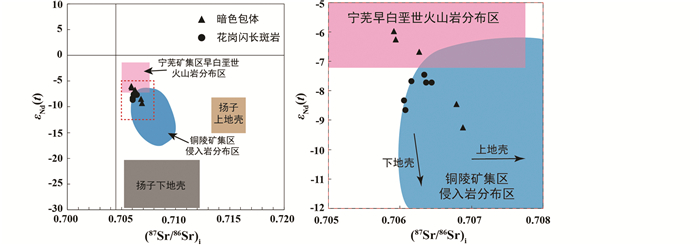
|
图 13 暗色包体与寄主岩石(87Sr/86Sr)i-εNd(t)图解 扬子上、下地壳陈江峰等, 1993; 邢凤鸣和徐祥, 1996; 王强等, 2003;宁芜早白垩世火山岩数据王元龙等, 2001; 史磊, 2013; Chen et al., 2007;铜陵矿集区侵入岩数据谢建成, 2008 Fig. 13 The (87Sr/86Sr)i vs. εNd(t) diagram of MMEs and host rock The data of upper and lower Yangtze crust was quoted from Chen et al., 1993; Xing and Xu, 1996; Wang et al., 2003; the data of Ningwu basin Early Cretaceous volcanic rocks was quoted from Wang et al., 2001; Shi, 2013; Chen et al., 2007; the data of Tongling ore district intrusive rocks was quoted from Xie, 2008 |
由于锆石具有较高的封闭温度,所以其同位素体系相对较稳定,其原始同位素比值在后期的岩浆、变质等作用下不易被改变(Griffin et al., 2002),因此锆石的同位素特征可作为指示岩浆起源、揭示岩浆演化过程的有利证据(吴福元等, 2007)。地幔的高温环境使得幔源岩浆和与其平衡的锆石具有相对均一的氧同位素组成(δ18O=5.3‰±0.3‰),并且结晶分异作用很难改变这种同位素特征(Valley et al., 2005)。因此目前限定地幔和地壳等端元组份性质的主要方法即为锆石原位Hf-O同位素示踪(Kemp et al., 2007; Bolhar et al., 2008; Wang et al., 2016)。
有学者报道宁芜矿集区早白垩世火山岩的εHf(t)值为-6.9~-0.7(王元龙等, 2001; 刘洪等, 2002; Wang et al., 2006; Yan et al., 2008; 侯可军和袁顺达, 2010; 孙维安等, 2017)。宣城荞麦山寄主花岗闪长斑岩的εHf(t)=-12.1~-8.1,暗色包体的εHf(t)=-12.7~-5.8。荞麦山暗色包体的εHf(t)值与宁芜矿集区早白垩世火山岩的εHf(t)值分布区有部分重叠(图 14a),这说明暗色包体可能起源于富集岩石圈地幔,而较宽的分布区间可能指示其受到壳源古老物质的混染。寄主岩石的εHf(t)值相对于包体远离宁芜矿集区早白垩世火山岩区域(图 14a),但总体上较为一致可能指示着其主要起源于富集岩石圈地幔。寄主花岗闪长斑岩和包体的εHf(t)值均远离2.55Ga大陆下地壳岩石的εHf(t)值分布区(Vervoort et al., 1996),这意味着岩浆源区主要以富集岩石圈地幔为主,但是有部分古老地壳物质组分的参与。O同位素方面,寄主花岗闪长斑岩和暗色包体的δ18O值分布区间大致相同(图 14b),均较为靠近与地幔平衡的锆石的δ18O值,指示源区以幔源成分为主,但是其与地幔值的差异,暗示有壳源物质的参与。
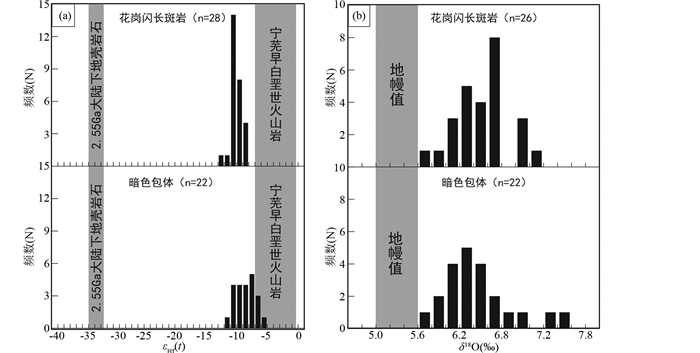
|
图 14 暗色包体与寄主岩石εHf(t)分布图(a)和δ18O值分布图(b) (a)宁芜地区早白垩世火山岩数据王元龙等, 2001; 刘洪等, 2002; Wang et al., 2006; Yan et al., 2008; 侯可军和袁顺达, 2010; 孙维安等, 2017; 2.25Ga大陆下地壳岩石数据引自Vervoort et al., 1996; (b)地幔值范围引自Valley et al., 1998, 2005 Fig. 14 εHf(t) values frequency spectrum (a) and δ18O frequency spectrum (b) of MMEs and host rock (a) the data of Ningwu basin Early Cretaceous volcanic rocks was quoted from Wang et al., 2001; Liu et al., 2002; Wang et al., 2006; Yan et al., 2008; Hou and Yuan et al., 2010; Sun et al., 2017; the data of 2.25Ga lower crust rocks was quoted from Vervoort et al., 1996; (b) the data of mantle zircon δ18O range was quoted from Valley et al., 1998, 2005 |
前文已述,暗示包体主要有源区残留体、围岩捕掳体、同源岩浆早阶段的析离体以及岩浆混合成因四种观点。
荞麦山暗色包体的年龄(141.3±1.1Ma)与寄主花岗闪长斑岩的年龄(139.5±1.2Ma)在误差范围内完全一致,且在暗色包体中没有发现继承锆石,另外暗色包体具有典型的岩浆结构,说明荞麦山暗色包体不可能是源岩残留体或围岩捕掳体成因。寄主岩石与暗色包体在微量元素(图 9)及Sr同位素方面无明显差异,这可能是由于其为同源岩浆演化或岩浆混合过程中微量元素和Sr同位素均匀化所导致的。因为在岩浆混合的过程中微量元素、Sr同位素等可以在原结构上直接交换,均匀化的过程比主量元素更易进行(Troll and Schmincke, 2002)。在εNd(t)值方面,暗色包体及寄主岩石之间的趋势可能为岩浆混合作用所致也可能为同化混染所致(图 15a)。此外由于锆石在岩浆体系中较早结晶,使得混合端元岩浆的Hf同位素特征得以保留,故可以通过锆石的原位Hf同位素反应岩浆体系演化过程(吴福元等, 2007; Chen et al., 2009)。荞麦山暗色包体与寄主岩石的εHf(t)值(图 15b)总体比较一致,但是包体的εHf(t)值分布范围明显大于寄主岩石,这么大的同位素变化显然不能由单一源区岩浆在封闭体系中结晶分异所致,指示可能存在两种不同来源岩浆的混合。除利用同位素进行岩浆演化过程的鉴别外,斜长石的环带特征记录了其结晶时岩浆演化的特征,是鉴别岩浆演化机制的重要依据(Tsuchiyama, 1985; 谢磊等, 2004)。荞麦山花岗闪长斑岩(寄主岩石)中的斜长石斑晶多具有环带结构(图 10a, b),对环带结构进行电子探针测试,并计算相应点位的斜长石牌号(An值),剖面位置及牌号如图 10所示。结果显示两颗斜长石均具有不平衡结构,这种不平衡结构是单一源区岩浆在封闭体系下演化无法形成的,可能指示着不同源区的岩浆发生混合作用导致体系的成分突变。斜长石元素面扫描的结果同样支持岩浆混合的成因,进行面扫描的斜长石核幔具有不同的性质,其具有富Ca的核和富Na的幔(图 11b, d),我们选择了一个剖面(图 11n)并计算其对应的斜长石牌号分布(图 11o),发现斜长石核部和幔部的牌号是突变的,正常的岩浆演化不会造成牌号的突变,因此我们认为该斜长石的核部是两种岩浆中偏基性的岩浆晶出的斜长石,与偏酸性岩浆混合过程中发生了晶体交换而形成的捕掳晶,幔部为混合后的岩浆围绕早期的捕掳晶继续生长,在幔部生长过程中两个端元的岩浆继续发生化学成分交换,导致了幔部同样出现了不平衡结构。沿核幔边界的K、Rb元素异常可能是由捕掳晶被捕获后形成的绢云母溶蚀带所致。
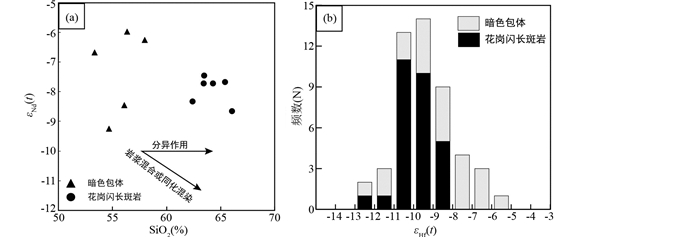
|
图 15 暗色包体与寄主岩石εNd(t)-SiO2图解(a)及εHf(t)值分布对比图(b) Fig. 15 εNd(t) vs. SiO2 diagram (a) and εHf(t) frequency spectrum (b) of MMEs and host rock |
在侏罗世晚期(165~145Ma),古太平洋板块开始向亚洲板块俯冲,导致了中国东部受挤压整体抬升形成高原,由于地壳抬升导致了侏罗世沉积缺失,岩石圈增厚(董树文等, 1993; 张旗等, 2001)。谢建成等(2008)讨论了铜陵地区侵入岩源区的富集过程,认为其源区受到俯冲板片的脱水作用产生的流体或熔体的交代富集作用。这种富集地幔来源的玄武质岩浆发生底侵作用,幔源岩浆与下地壳源岩浆混合,混合后的母岩浆发生分异作用最终形成铜陵矿集区燕山晚期中酸性侵入岩(徐晓春等, 2012)。铜陵矿集区侵入岩常与中基性岩体伴生并发育中基性暗色包体(杜杨松和李学军, 1997; 杜杨松和李铉具, 2004; 杜杨松等, 2004),侵入岩发育岩浆混合结构(Wu et al., 2000; 狄永军等, 2005)等特征也都记录了铜陵矿集区燕山晚期侵入岩形成与岩浆混合作用的密切关系。宣城荞麦山矿床侵入岩成岩时代与铜陵矿集区岩浆活动时代一致且地理位置邻近,此外荞麦山花岗闪长斑岩及暗色包体均具有与铜陵矿集区中酸性侵入岩类似的LREE富集、HREE亏损、轻重稀土强烈分馏、富集大离子亲石元素、亏损Nb、Ta、Ti等地球化学特征(图 9a, b),这些特征指示了荞麦山花岗闪长斑岩成岩过程可能与铜陵矿集区侵入岩形成过程类似。
深地震反射剖面揭示出安徽沿江地区的下地壳普遍存在似层状强反射层,该反射层被认为是由基性或超基性岩浆底侵所引起(吕庆田等, 2005)。在构造背景判别图解上,均落于火山弧构造背景区域内(图 16a, b),显示了荞麦山矿床侵入岩形成与俯冲作用的亲缘关系。麦山暗色包体的εNd(t)值及εHf(t)值均与富集地幔的区间有重叠的部分,这意味着暗色包体所代表的端元可能为富集地幔来源的基性岩浆端元。而其个别样品的εNd(t)值和εHf(t)值更偏向壳源物质,可能指示在底侵作用的过程中同化了部分壳源古老物质,但其并非大规模的同化混染,所以部分样品保留了幔源的特征。这种加入了部分古老物质的基性岩浆注入到壳源酸性岩浆房中,形成了暗色包体,同时包体岩浆与寄主岩浆透过接触边界发生了化学交换以及机械交换(晶体),导致了寄主岩石中出现代表暗色包体的捕掳晶以及暗色包体和寄主岩石的Sr同位素平衡。因此荞麦山花岗闪长斑岩为受古太平洋板块俯冲脱水作用交代形成的富集地幔部分熔融形成的玄武质岩浆发生底侵作用并同化混染了部分古老物质,底垫的岩浆烘烤下地壳促使其形成了少量壳源岩浆,随后底侵的幔源岩浆注入壳源岩浆中形成中酸性混合岩浆并有部分基性岩浆团块形成暗色包体,最后混合的岩浆上升侵位至地壳浅部形成矿区侵入体。

|
图 16 构造背景判别图解(底图据Pearce et al., 1984) WPG-板内花岗岩;Syn-COLG-同碰撞花岗岩;VGA-火山弧花岗岩;ORG-洋脊花岗岩 Fig. 16 Tectonic setting discrimination diagrams (base map after Pearce et al., 1984) WPG-Within Plate Granites; Syn-COLG-Syn-collision Granites; VGA-Volcanic Arc Granites; ORG-Ocean Ridge Granites |
岩浆混合作用是壳幔相互作用的主要表现形式,有研究表明岩浆底侵-混合作用有利于多数金属矿床的成矿作用(曲晓明和王鹤年, 1997; 李昌年, 2002; Zhong et al., 2004)。国内外多个矿床均报道了岩浆混合作用的存在(Anita and Vitaly, 2010; 王玉往等, 2008; 曹殿华等, 2009; 龙灵利等, 2010; Yang et al., 2017)。由于在岩浆演化过程中,从基性岩浆到酸性岩浆的过程中,金属元素(如:Cu、Au等)会发生丢失,导致以酸性岩为主的地壳中Cu、Au的丰度较低(Sun et al., 2004),因此Cu主要来源于地幔或新生地壳,但荞麦山矿床侵入岩εHf(t)值为负,可以排除新生地壳重熔形成。在地幔熔融的过程中,Cu等金属元素趋向集中在硫化物熔体中,而在地幔熔融源区处于高氧化态时,由于硫化物被氧化,会导致S元素进入硅酸盐熔体中。与俯冲交代有关的岩浆岩往往具有富水和高氧逸度的特征(Ballard et al., 2002; Liang et al., 2006; Kelley and Cottrell, 2009; Sillitoe, 2010; Sun, 2015)。俯冲板片携带大量的富Fe3+的陆源碎屑沉积物,俯冲洋壳也因为海水蚀变而使氧逸度升高,这些都可能使得受到俯冲板片产生的流体或熔体交代的地幔楔氧逸度增高。这种交代地幔源区部分熔融形成的富金属元素和硫的高温、高氧逸度、富水的岩浆发生底侵作用,有利于下地壳岩石发生部分熔融形成壳源岩浆,混合作用的发生增加了混合岩浆的挥发份含量,抑制了熔体中含Cu硫化物的分离,混合过程中会释放SO2并伴随着亲铜元素迁移,造成铜的富集(刘成东等, 2002; 彭惠娟, 2011),有利于矿床的形成。长江中下游成矿带铜陵矿集区中也有大量研究证明矿床形成与壳幔岩浆混合作用有关(Guo et al., 2013; 张志辉等, 2013; Wang et al., 2015; Liu et al., 2016),这与荞麦山矿床成矿岩体起源于富集地幔并发生了壳幔岩浆混合作用结论一致,也说明了宣城矿集区~140Ma的岩浆活动与铜陵矿集区具有一致性。
宣城矿集区荞麦山矿床除以Cu为主外也伴生有较多的W矿(刘晓明和段留安, 2015)。Cu主要来源于地幔源区(Sun et al., 2004),W在地幔和地壳中的丰度分别为0.13×10-6和1.1×10-6(刘英俊和马东升, 1987),指示钨主要来源于地壳(Zhang et al., 2014)。刘学龙等(2017)的研究证明Cu-W共生的矿床可以是两期岩浆活动导致的不同成矿作用叠加的结果。但是荞麦山矿区内未见其它期次岩浆活动,排除了多期成矿作用叠加的可能。除多期成矿作用叠加外,也有研究表明Cu-W共生矿床形成多受成矿岩体的岩浆源区控制,且其成矿岩体源区多为壳幔混合源区(毛志昊, 2016; 刘经纬等, 2017; 陈伟等, 2018; 孔志岗等, 2018; 张赞赞等, 2018)。壳幔混合作用的方式可以为幔源岩浆同化混染壳源物质或者幔源岩浆与壳源岩浆混合,前文已述,荞麦山暗色包体的同化混染作用不显著,主要以幔源岩浆与壳源岩浆的混合作用为主,幔源岩浆为成矿提供了成矿金属元素铜,而壳源岩浆则提供了成矿金属元素钨。
5 结论(1) 宣城矿集区荞麦山矿床成矿岩体花岗闪长斑岩形成时代为139.5±1.2Ma,暗色包体形成时代为141.3±1.1Ma;与铜陵矿集区等断隆区岩浆活动时间一致,是长江中下游成矿带第一阶段岩浆活动产物。
(2) 荞麦山矿床侵入岩形成过程与铜陵矿集区同时代中酸性侵入岩形成机制类似,是由受古太平洋板块俯冲相关作用形成的富集地幔起源的岩浆与壳源岩浆混合形成的母岩浆上升侵位形成。
(3) 荞麦山矿床成矿岩体形成过程中的不同源区的岩浆混合使来自不同源区的成矿物质同时在母岩浆中富集,并最终形成铜钨共生的矽卡岩矿床;岩浆混合作用可能是导致铜钨共生矿床形成的成因之一。
致谢 本文在野外工作和样品测试过程中得到了华东冶金地质勘查局综合地质大队、宣城华通矿业有限公司、澳大利亚国立大学地球科学中心(RSES)、合肥工业大学矿物原位分析实验室汪方跃副教授等的大力支持,在此表示感谢。同时感谢审稿人对本文提出的宝贵意见。
谨以此文敬贺岳书仓教授八十八华诞!
Andersen T and Griffin WL. 2004. Lu-Hf and U-Pb isotope systematics of zircons from the Storgangen intrusion, Rogaland intrusive complex, SW Norway:Implications for the composition and evolution of Precambrian lower crust in the Baltic Shield. Lithos, 73(3-4): 271-288 DOI:10.1016/j.lithos.2003.12.010 |
Anita NB and Vitaly IS. 2010. Contribution from mafic melt to the Zhireken porphyry Mo-Cu deposit, Eastern Transbaikalia, Russia:Evidence from mafic microgranular enclaves. International Journal of Economic and Environment Geology, 1(1): 42-54 |
Ballard JR, Palin MJ and Campbell IH. 2002. Relative oxidation states of magmas inferred from Ce(Ⅳ)/Ce(Ⅲ) in zircon:Application to porphyry copper deposits of northern Chile. Contributions to Mineralogy and Petrology, 144(3): 347-364 DOI:10.1007/s00410-002-0402-5 |
Barbarin B. 2005. Mafic magmatic enclaves and mafic rocks associated with some granitoids of the central Sierra Nevada batholith, California:Nature, origin, and relations with the hosts. Lithos, 80(1-4): 155-177 DOI:10.1016/j.lithos.2004.05.010 |
Bolhar R, Weaver SD, Whitehouse MJ, Palin JM, Woodhead JD and Cole JW. 2008. Sources and evolution of arc magmas inferred from coupled O and Hf isotope systematics of plutonic zircons from the Cretaceous Separation Point Suite (New Zealand). Earth and Planetary Science Letters, 268(3-4): 312-324 DOI:10.1016/j.epsl.2008.01.022 |
Boynton WV. 1984. Geochemistry of the rare earth elements:Meteorite studies. Developments in Geochemistry, 2: 63-114 DOI:10.1016/B978-0-444-42148-7.50008-3 |
Cao DH, Wang AJ, Li WC, Wang GS, Li RP and Li YK. 2009. Magma mixing in the Pulang porphyry copper deposit:Evidence from petrology and element geochemistry. Acta Geologica Sinica, 83(2): 166-175 (in Chinese with English abstract) |
Chang YF, Liu XP and Wu YC. 1991. The Lower Yangtze Metallogenic Belt. Beijing: Geological Publishing House, 1-379 (in Chinese)
|
Chang YF, Zhou TF and Fan Y. 2017. Review of exploration and geological research progress in the Middle-Lower Yangtze River Valley Metallogenic Belt. Acta Petrologica Sinica, 33(11): 3333-3352 (in Chinese with English abstract) |
Chappell BW and White AJR. 1991. Restite enclaves and the restite model. In: Didier J and Barbarin B (eds.). Enclaves and Granite Petrology. Amsterdam: Elsevier, 375-381
|
Chen B, He JB and Ma XH. 2009. Petrogenesis of mafic enclaves from the north Taihang Yanshanian intermediate to felsic plutons:Evidence from petrological, geochemical, and zircon Hf-O isotopic data. Science in China (Series D), 52(9): 1331-1344 DOI:10.1007/s11430-009-0130-z |
Chen J, Wang RC, Zhu JC, Lu JJ and Ma DS. 2013. Multiple-aged granitoids and related tungsten-tin mineralization in the Nanling Range, South China. Science China (Earth Sciences), 56(12): 2045-2055 DOI:10.1007/s11430-013-4736-9 |
Chen JF, Zhou TX, Li XM, Foland KA, Huang CY and Lu W. 1993. Sr and Nd isotopic constraints on source regions of the intermediate and acid intrusions from southern Anhui Province. Geochimica, (3): 261-268 (in Chinese with English abstract) |
Chen W, Chen B and Sun KK. 2018. Petrogenesis of the Maogongdong highly differentiated granite in the Dahutang tungsten ore field, Jiangxi Province. Acta Petrologica Sinica, 34(6): 1704-1724 (in Chinese with English abstract) |
Chen WF, Chen PR, Huang HY, Ding X and Sun T. 2007. Study on the chronology and geochemistry of Baimashan granite and its mafic microgranular enclaves, Hunan province. Science in China (Series D), 37(7): 873-893 (in Chinese) |
Chen ZH, Xing GF, Guo KY, Zeng Y, Kuang FX, He ZY, Ke X, Yu MG, Zhao XL and Zhang Y. 2011. Zircon U-Pb ages of ore-bearing granitic bodies in northern Jiujiang-Ruichang Metallogenic district of the mineralization belt of the Middle-Lower Reaches of the Yangtze River, and its geological significance. Acta Geologica Sinica, 85(7): 1146-1158 (in Chinese with English abstract) |
Chen ZH, Guo KY and Zhao L. 2013. Zircon U-Pb dating and hf isotopic study on granitic intrusions in the basement of the Ningwu Basin. Bulletin of Mineralogy, Petrology and Geochemistry, 32(6): 704-712 (in Chinese with English abstract) |
Dahlquist JA. 2002. Mafic microgranular enclaves:Early segregation from metaluminous magma (Sierra de Chepes), Pampean Ranges, NW Argentina. Journal of South American Earth Sciences, 15(6): 643-655 DOI:10.1016/S0895-9811(02)00112-8 |
Di YJ, Zhao HL, Wu GG, Zhang D, Zang WS and Liu QH. 2005. Genesis of the intrusive rocks from the Tongling area during the Yanshanian and mixing of three-end-member magma. Geological Review, 51(5): 528-538 (in Chinese with English abstract) |
Didier J and Barbarin B. 1991. Enclaves and Granite Petrology. Amsterdam: Elsevier, 1-625
|
Donaire T, Pascual E, Pin C and Duthou JL. 2005. Microgranular enclaves as evidence of rapid cooling in granitoid rocks:The case of the Los Pedroches granodiorite, Iberian Massif, Spain. Contributions to Mineralogy and Petrology, 149(3): 247-265 DOI:10.1007/s00410-005-0652-0 |
Dong SW, He DL and Shi YH. 1993. Structural characteristics and emplacement mechanism of granitoid in Dongling, Anhui, China. Scientia Geologica Sinica, 28(1): 10-20 (in Chinese with English abstract) |
Du YS and Li XJ. 1997. Enclaves in the typical mining districts of Tongling, Anhui and their implication to the process of magmatism-metallogeny. Geological Journal of China Universities, 3(2): 171-182 (in Chinese with English abstract) |
Du YS and Lee HK. 2004. Discovery of gabbroic xenoliths from Early Cretaceous intrusions in Tongling, Anhui Province, China and its geological significance. Geological Journal of China Universities, 10(3): 332-342 (in Chinese with English abstract) |
Du YS, Qin XL and Tian SH. 2004. Mesozoic magmatic to hydrothermal process in the Tongguanshan ore field, Tongling, Anhui Province, China:Evidence from xenoliths and their hosts. Acta Petrologica Sinica, 20(2): 339-350 (in Chinese with English abstract) |
Duan LA, Gu HL, Yang XY, Yan ZZ and Sun WD. 2015. Chronology and Hf isotopic study of igneous rocks in the Liwan Cu-polymetal deposit in Guichi along the Middle-Lower Yangtze River. Acta Petrologica Sinica, 31(7): 1943-1961 (in Chinese with English abstract) |
Eggins SM, Grün R, McCulloch MT, Pike AWG, Chappell J, Kinsley L, Mortimer G, Shelley M, Murray-Wallace CV, Spötl C and Taylor L. 2005. In situ U-series dating by laser-ablation multi-collector ICPMS:New prospects for Quaternary geochronology. Quaternary Science Reviews, 24(23-24): 2523-2538 DOI:10.1016/j.quascirev.2005.07.006 |
Fan Y, Zhou TF, Yuan F, Qian CC, Lu SM and David C. 2008. LA-ICP-MS zircon U-Pb ages of the A-type granites in the Lu-Zong (Lujiang-Zongyang) area and their geological significances. Acta Petrologica Sinica, 24(8): 1715-1724 (in Chinese with English abstract) |
Fan Y, Zhou TF, Yuan F, Zhang LJ, Qian B, Ma L and David RC. 2010. Geochronology of the diorite porphyrites in Ning-Wu basin and their metallogenic significances. Acta Petrologica Sinica, 26(9): 2715-2728 (in Chinese with English abstract) |
Fan Y, Zhou TF, Yuan F, Zhang LJ, Qian B, Ma L, Xie J and Yang XF. 2011. Geochronology of the porphyry-like type iron deposits in Ning-Wu basin:Evidence from 40Ar-39Ar phlogopite dating. Acta Geologica Sinica, 85(5): 810-820 (in Chinese with English abstract) |
Griffin WL, Wang X, Jackson SE, Pearson NJ, O'Reilly SY, Xu XS and Zhou XM. 2002. Zircon chemistry and magma mixing, SE China:In-situ analysis of Hf isotopes, Tonglu and Pingtan igneous complexes. Lithos, 61(3-4): 237-269 DOI:10.1016/S0024-4937(02)00082-8 |
Guo WM, Lu JJ, Jiang SY, Zhang RQ and Zhao ZJ. 2013. Chronology, Hf isotopes, geochemistry, and petrogenesis of the magmatic rocks in the Shizishan ore field of Tongling, Anhui Province. Science China (Earth Sciences), 56(6): 993-1013 DOI:10.1007/s11430-013-4589-2 |
Hoskin PWO and Ireland TR. 2000. Rare earth element chemistry of zircon and its use as a provenance indicator. Geology, 28(7): 627-630 DOI:10.1130/0091-7613(2000)28<627:REECOZ>2.0.CO;2 |
Hou KJ and Yuan SD. 2010. Zircon U-Pb age and Hf isotopic composition of the volcanic and sub-volcanic rocks in the Ningwu basin and their geological implications. Acta Petrologica Sinica, 26(3): 888-902 (in Chinese with English abstract) |
Ickert RB, Hiess J, Williams IS, Holden P, Ireland TR, Lanc P, Schram N, Foster JJ and Clement SW. 2008. Determining high precision, in situ, oxygen isotope ratios with a SHRIMP Ⅱ:Analyses of MPI-DING silicate-glass reference materials and zircon from contrasting granites. Chemical Geology, 257(1-2): 114-128 DOI:10.1016/j.chemgeo.2008.08.024 |
Jiang F. 2017. Characteristics and genesis of magmatic rocks in the Chating Cu-Au ore district, Xuancheng City, Anhui Province. Master Degree Thesis. Hefei: Hefei University of Technology, 1-85 (in Chinese with English summary)
|
Jiang F, Xu XC, Qian SL, Wang M, Yang QG and Li K. 2017. Zircon U-Pb age and genesis of the ore-bearing quartz-dioritic porphyries in the Chating Cu-Au ore deposit, Xuancheng City, Anhui Province. Geological Journal of China Universities, 23(4): 591-605 (in Chinese with English abstract) |
Jiang YH, Jiang SY, Dai BZ, Liao SY, Zhao KD and Ling HF. 2009. Middle to Late Jurassic felsic and mafic magmatism in southern Hunan Province, Southeast China:Implications for a continental arc to rifting. Lithos, 107(3-4): 185-204 DOI:10.1016/j.lithos.2008.10.006 |
Kelley KA and Cottrell E. 2009. Water and the oxidation state of subduction zone magmas. Science, 325(5940): 605-607 DOI:10.1126/science.1174156 |
Kemp AIS, Hawkesworth CJ, Foster GL, Paterson BA, Woodhead JD, Hergt JM, Gray CM and Whitehouse MJ. 2007. Magmatic and crustal differentiation history of granitic rocks from Hf-O isotopes in zircon. Science, 315(5814): 980-983 DOI:10.1126/science.1136154 |
Kong ZG, Liang T, Mao JW, Xu SF, Xu HB, Yan PP and Jin XY. 2018. Study on perogenesis of granodiorite, metallogenic epoch and petrogenetic-metallogenetic setting in the Zhuxiling tungsten polymetallic deposit, southern Anhui Province, China. Acta Petrologica Sinica, 34(9): 2632-2656 (in Chinese with English abstract) |
Li CN. 2002. Comment on the magma mixing and their research. Geological Science and Technology Information, 21(4): 49-54 (in Chinese with English abstract) |
Li JW, Zhao XF, Zhou MF, Vasconcelos P, Ma CQ, Deng XD, De Souza ZS, Zhao YX and Wu G. 2008. Origin of the Tongshankou porphyry-skarn Cu-Mo deposit, eastern Yangtze craton, eastern China:Geochronological, geochemical, and Sr-Nd-Hf isotopic constraints. Mineralium Deposita, 43(3): 315-336 DOI:10.1007/s00126-007-0161-3 |
Li JW, Zhao XF, Zhou MF, Ma CQ, De Souza ZS and Vasconcelos P. 2009. Late Mesozoic magmatism from the Daye region, eastern China:U-Pb ages, petrogenesis, and geodynamic implications. Contributions to Mineralogy and Petrology, 157(3): 383-409 DOI:10.1007/s00410-008-0341-x |
Li JW, Vasconcelos PM, Zhou MF, Deng XD, Cohen B, Bi SJ, Zhao XF and Selby D. 2014. Longevity of magmatic-hydrothermal systems in the Daye Cu-Fe-Au district, eastern China with implications for mineral exploration. Ore Geology Reviews, 57: 375-392 DOI:10.1016/j.oregeorev.2013.08.002 |
Liang HY, Campbell IH, Allen C, Sun WD, Liu CQ, Yu HX, Xie YW and Zhang YQ. 2006. Zircon Ce4+/Ce3+ ratios and ages for Yulong ore-bearing porphyries in eastern Tibet. Mineralium Deposita, 41(2): 152-159 DOI:10.1007/s00126-005-0047-1 |
Liu CD, Zhang WQ, Mo XX, Luo ZH, Yu XH, Li SW and Zhao X. 2002. Features and origin of mafic microgranular enclaves in the Yuegelu granite in the Eastern Kunlun. Geological Bulletin of China, 21(11): 739-744 (in Chinese with English abstract) |
Liu GX, Yuan F, Deng YF, Sun WA, Yang D and Li XS. 2017. Geochronology, geochemistry and geological characteristics of the diorite from Hehuashan zinc-lead deposit, Tongling, Anhui Province. Acta Petrologica Sinica, 33(11): 3581-3598 (in Chinese with English abstract) |
Liu GX, Yuan F, Deng YF, Jowitt SM, Sun WA, White NC, Yang D, Li XS, Zhou TF and Huizenga JM. 2018a. The genesis of the Hehuashan Pb-Zn deposit and implications for the Pb-Zn prospectivity of the Tongling district, Middle-Lower Yangtze River Metallogenic Belt, Anhui Province, China. Ore Geology Reviews, 101: 105-121 DOI:10.1016/j.oregeorev.2018.07.014 |
Liu H, Qiu JS, Lo CH, Xu XS, Ling WL and Wang DZ. 2002. Petrogenesis of the Mesozoic potash rich volcanic rocks in the Luzong basin, Anhui Province:Geochemical constraints. Geochimica, 31(2): 129-140 (in Chinese with English abstract) |
Liu JW, Chen B, Chen JS, Li Z and Sun KK. 2017. Highly differentiated granite from the Zhuxi tungsten (copper) deposit in northeastern Jiangxi Province:Petrogenesis and their relationship with W-mineralization. Acta Petrologica Sinica, 33(10): 3161-3182 (in Chinese with English abstract) |
Liu SA, Li SG, He YS and Huang F. 2010. Geochemical contrasts between Early Cretaceous ore-bearing and ore-barren high-Mg adakites in central-eastern China:Implications for petrogenesis and Cu-Au mineralization. Geochimica et Cosmochimica Acta, 74(24): 7160-7178 DOI:10.1016/j.gca.2010.09.003 |
Liu XL, Li WC, Yang FC, Zhang N, Yan TL and Luo Y. 2017. Zircon U-Pb age and Hf isotopic composition of the two-period magmatism of the Xiuwacu Mo-W-Cu deposit in the Geza arc belt, Yunnan, and their tectonic significance. Acta Geologica Sinica, 91(4): 849-863 (in Chinese with English abstract) |
Liu XM and Duan LA. 2015. Geological features and metallogenic regularity of the Tongshan-Qiaomaishan Cu-S-W-Fe polymetallic ore deposit in Xuancheng City. Geology of Anhui, 25(3): 174-178 (in Chinese with English abstract) |
Liu YJ and Ma DS. 1987. Geochemistry of Tungsten. Beijing: Science Press, 1-232 (in Chinese)
|
Liu Z, Yang XY, Liu CM, Huang DZ, Zhou WJ, Teng X, Liang EY and Dai TG. 2018b. Genesis of Early Cretaceous porphyrite-type iron deposits and related sub-volcanic rocks in the Ningwu volcanic basin, Middle-Lower Yangtze Metallogenic Belt, Southeast China. International Geology Review, 60(11-14): 1507-1528 DOI:10.1080/00206814.2017.1419883 |
Liu ZF, Shao YJ, Wei HT and Wang C. 2016. Rock-forming mechanism of Qingshanjiao intrusion in Dongguashan copper (gold) deposit, Tongling area, Anhui Province, China. Transactions of Nonferrous Metals Society of China, 26(9): 2449-2461 DOI:10.1016/S1003-6326(16)64365-0 |
Long LL, Wang YW, Wang JB, Wang LJ, Li QL, Wang SL, Pu KX, Zhang HQ and Liao Z. 2010. Magma mixing in the Xilekuduke Cu-Mo ore district in Xinjiang:Evidence from zircon U-Pb chronology. Acta Petrologica Sinica, 26(2): 449-456 (in Chinese with English abstract) |
Ludwig KR. 2001. User's Manual for Isoplot/Ex Rev. 2.49. Berkeley: Berkeley Geochronology Center, 1-56
|
Lü QT, Hou ZQ, Yang ZS and Shi DN. 2005. Underplating in the Middle-Lower Yangtze Valley and model of geodynamic evolution:Constraints from geophysical data. Science in China (Series D), 48(7): 985-999 DOI:10.1360/03yd0205 |
Maas R, Nicholls IA and Legg C. 1997. Igneous and metamorphic enclaves in the S-type Deddick granodiorite, Lachlan Fold Belt, SE Australia:Petrographic, geochemical and Nd-Sr isotopic evidence for crustal melting and magma mixing. Journal of Petrology, 38(7): 815-841 DOI:10.1093/petroj/38.7.815 |
Maniar PD and PiccoliI PM. 1989. Tectonic discrimination of granitoids. Geol. Soc. Am. Bull., 101: 635-643 DOI:10.1130/0016-7606(1989)101<0635:TDOG>2.3.CO;2 |
Mao JW, Stein H, Du AD, Zhou TF, Mei YX, Li YF, Zang WS and Li JW. 2004. Molybdenite Re-Os precise dating for molybdenite from Cu-Au-Mo deposits in the Middle-Lower Reaches of Yangtze River Belt and its implications for mineralization. Acta Geologica Sinica, 78(1): 121-131 (in Chinese with English abstract) |
Mao JW, Wang YT, Lehmann B, Yu JJ, Du AD, Mei YX, Li YF, Zang WS, Stein HJ and Zhou TF. 2006. Molybdenite Re-Os and albite 40Ar/39Ar dating of Cu-Au-Mo and magnetite porphyry systems in the Yangtze River Valley and metallogenic implications. Ore Geology Reviews, 29(3-4): 307-324 DOI:10.1016/j.oregeorev.2005.11.001 |
Mao JW, Xie GQ, Duan C, Pirajno F, Ishiyama D and Chen YC. 2011. A tectono-genetic model for porphyry-skarn-stratabound Cu-Au-Mo-Fe and magnetite-apatite deposits along the Middle-Lower Yangtze River Valley, eastern China. Ore Geology Reviews, 43(1): 294-314 DOI:10.1016/j.oregeorev.2011.07.010 |
Mao ZH. 2016. Geodynamic setting and mineralization of the giant veinlets-disseminated tungsten ore field in Jiangxi Province, China. Ph. D. Dissertation. Beijing: China University of Geosciences, 1-149 (in Chinese with English summary)
|
Middlemost EAK. 1985. Magmas and Magmatic Rocks. London: Longman, 1-266
|
Middlemost EAK. 1994. Naming materials in the magma/igneous rock system. Earth-Science Reviews, 37(3-4): 215-224 DOI:10.1016/0012-8252(94)90029-9 |
Neves SP and Vauchez A. 1995. Successive mixing and mingling of magmas in a plutonic complex of Northeast Brazil. Lithos, 34(4): 275-299 DOI:10.1016/0024-4937(94)00012-Q |
Nie LQ, Zhou TF, Fan Y, Zhang LJ, Cooke D and White N. 2017. Geology, geochemistry and genesis of the Makou magnetite-apatite deposit in the Luzong volcanic basin, Middle-Lower Yangtze River Valley Metallogenic Belt, eastern China. Ore Geology Reviews, 91: 264-277 DOI:10.1016/j.oregeorev.2017.09.022 |
Paton C, Hellstrom J, Paul B, Woodhead J and Hergt J. 2011. Iolite:Freeware for the visualisation and processing of mass spectrometric data. Journal of Analytical Atomic Spectrometry, 26(12): 2508-2518 DOI:10.1039/c1ja10172b |
Pearce JA, Harris NBW and Tindle AG. 1984. Trace element discrimination diagrams for the tectonic interpretation of granitic rocks. Journal of Petrology, 25(4): 956-983 DOI:10.1093/petrology/25.4.956 |
Peccerillo A and Taylor SR. 1976. Geochemistry of Eocene calc-alkaline volcanic rocks from the kastamonu area, northern Turkey. Contributions to Mineralogy and Petrology, 58(1): 63-81 DOI:10.1007/BF00384745 |
Peng HJ. 2011. Preliminary study of genetic mineralogy and prospecting mineralogy from Jiama polymetallic copper deposit, Tibet. Master Degree Thesis. Chengdu: Chengdu University of Technology, 1-80 (in Chinese with English summary)
|
Peng ZL, Grapes R, Zhuang WM and Zhang XH. 2011. Genesis of mafic microgranular enclaves in granites in SE China. Earth Science Frontiers, 18(1): 82-88 (in Chinese with English abstract) |
Perugini D, Poli G, Christofides G and Eleftheriadis G. 2003. Magma mixing in the Sithonia Plutonic Complex, Greece:Evidence from mafic microgranular enclaves. Mineralogy and Petrology, 78(3-4): 173-200 DOI:10.1007/s00710-002-0225-0 |
Pirajno F and Zhou TF. 2015. Intracontinental porphyry and porphyry-skarn mineral systems in Eastern China:Scrutiny of a special case "Made-in-China". Economic Geology, 110(3): 603-629 DOI:10.2113/econgeo.110.3.603 |
Qu XM and Wang HN. 1997. Dynamic study on the crustal-mantle magma mixing and emplacement mechanism of Guojialing granite. Scientia Geologica Sinica, 32(4): 445-454 (in Chinese with English abstract) |
Shi L. 2013. Petrogenesis of K-rich volcanic rocks of Niangniangshan Formation in Ningwu basin. Master Degree Thesis. Hefei: Hefei University of Technology, 1-62 (in Chinese with English summary)
|
Sillitoe RH. 2010. Porphyry copper systems. Economic Geology, 105(1): 3-41 DOI:10.2113/gsecongeo.105.1.3 |
Sun SS and McDonough WF. 1989. Chemical and isotopic systematics of oceanic basalts: Implications for mantle composition and processes. In: Sanders AD and Norry MJ (eds.). Magmatism in Ocean Basins. Geological Society London Special Publications, 42(1): 313-345
|
Sun WA, Yuan F, Jowitt SM, Zhou TF, Hollings P, Liu GX and Li XH. 2017. Geochronology and geochemistry of the Fe ore-bearing Zhonggu intrusions of the Ningwu basin:Implications for tectonic setting and contemporaneous Cu-Au mineralization in the Middle-Lower Yangzte Metallogenic Belt. Ore Geology Reviews, 84: 246-272 DOI:10.1016/j.oregeorev.2017.01.007 |
Sun WA, Yuan F, Deng YF, Liu GX, Yang D, Li XS and Fu B. 2017. Hf-O isotope characteristics for ore-related intrusions of typical iron deposits in Zhonggu ore field, Ningwu Basin. Acta Petrologica Sinica, 33(11): 3559-3580 (in Chinese with English abstract) |
Sun WD, Xie Z, Chen JF, Zhang X, Chai ZF, Du AD, Zhao JS, Zhang CH and Zhou TF. 2003. Os-Os dating of copper and molybdenum deposits along the Middle and Lower Reaches of the Yangtze River, China. Economic Geology, 98(1): 175-180 |
Sun WD, Arculus RJ, Kamenetsky VS and Binns RA. 2004. Release of gold-bearing fluids in convergent margin magmas prompted by magnetite crystallization. Nature, 431(7011): 975-978 DOI:10.1038/nature02972 |
Sun WD, Huang RF, Li H, Hu YB, Zhang CC, Sun SJ, Zhang LP, Ding X, Li CY, Zartman RE and Ling MX. 2015. Porphyry deposits and oxidized magmas. Ore Geology Reviews, 65: 97-131 DOI:10.1016/j.oregeorev.2014.09.004 |
Tang YC, Wu YC, Chu GZ, Xing FM, Wang YM, Cao FY and Chang YF. 1998. Geology of Copper-Gold Polymetallic Deposits in the along-Changjiang Area of Anhui Province. Beijing: Geological Publishing House, 1-85 (in Chinese)
|
Troll VR and Schmincke HU. 2002. Magma mixing and crustal recycling recorded in ternary feldspar from compositionally zoned peralkaline ignimbrite 'a', Gran Canaria, Canary Islands. Journal of Petrology, 43(2): 243-270 DOI:10.1093/petrology/43.2.243 |
Tsuchiyama A. 1985. Dissolution kinetics of plagioclase in the melt of the system diopside-albite-anorthite, and origin of dusty plagioclase in andesites. Contributions to Mineralogy and Petrology, 89(1): 1-16 DOI:10.1007/BF01177585 |
Valley JW, Kinny PD, Schulze DJ and Spicuzza MJ. 1998. Zircon megacrysts from kimberlite:Oxygen isotope variability among mantle melts. Contributions to Mineralogy and Petrology, 133(1-2): 1-11 DOI:10.1007/s004100050432 |
Valley JW, Lackey JS, Cavosie AJ, Clechenko CC, Spicuzza MJ, Basei MAS, Bindeman IN, Ferreira VP, Sial AN, King EM, Peck WH, Sinha AK and Wei CS. 2005. 4.4 billion years of crustal maturation:Oxygen isotope ratios of magmatic zircon. Contributions to Mineralogy and Petrology, 150(6): 561-580 DOI:10.1007/s00410-005-0025-8 |
Vernon RH. 1984. Microgranitoid enclaves in granites:Globules of hybrid magma quenched in a plutonic environment. Nature, 309(5967): 438-439 DOI:10.1038/309438a0 |
Vervoort JD, Patchett PJ, Gehrels GE and Nutman AP. 1996. Constraints on early Earth differentiation from hafnium and neodymium isotopes. Nature, 379(6566): 624-627 DOI:10.1038/379624a0 |
Wang FY, Ge C, Ning SY, Nie LQ, Zhong GX and White NC. 2017. A new approach to LA-ICP-MS mapping and application in geology. Acta Petrologica Sinica, 33(11): 3422-3436 (in Chinese with English abstract) |
Wang J, Wu MA, Li XD, Zhang S, Zhao WG and Wei GH. 2014. Zircon U-Pb dating, geochemical characteristics of Early-Cretaceous diorite-porphyrites in Luzhong basin and their implications for mineralization. Acta Geologica Sinica, 88(4): 547-561 (in Chinese with English abstract) |
Wang Q, Xu JF, Zhao ZH, Xiong XL and Bao ZW. 2003. Petrogenesis of the Mesozoic intrusive rocks in the Tongling area, Anhui Province, China and their constraint on geodynamic process. Science in China (Series D), 46(8): 801-815 DOI:10.1007/BF02879524 |
Wang Q, Wyman DA, Xu JF, Zhao ZH, Jian P, Xiong XL, Bao ZW, Li CF and Bai ZH. 2006. Petrogenesis of Cretaceous adakitic and shoshonitic igneous rocks in the Luzong area, Anhui Province (eastern China):Implications for geodynamics and Cu-Au mineralization. Lithos, 89(3-4): 424-446 DOI:10.1016/j.lithos.2005.12.010 |
Wang SW, Zhou TF, Yuan F, Fan Y, Zhang LJ and Song YL. 2015. Petrogenesis of Dongguashan skarn-porphyry Cu-Au deposit related intrusion in the Tongling district, eastern China:Geochronological, mineralogical, geochemical and Hf isotopic evidence. Ore Geology Reviews, 64: 53-70 DOI:10.1016/j.oregeorev.2014.06.012 |
Wang SW, Zhou TF, Yuan F, Fan Y, Cooke DR, Zhang LJ, Fu B and White NC. 2016. Geochemical characteristics of the Shujiadian Cu deposit related intrusion in Tongling:Petrogenesis and implications for the formation of porphyry Cu systems in the Middle-Lower Yangtze River Valley Metallogenic Belt, eastern China. Lithos, 252-253: 185-199 DOI:10.1016/j.lithos.2016.02.013 |
Wang SW, Yuan F, Wang B and Jiang L. 2018. Chronological, geochemical characteristics of the K-feldspar granite from Shujiadian intrusion, Tongling ore district:Its significance. Acta Petrologica Sinica, 34(1): 241-254 (in Chinese with English abstract) |
Wang YL, Zhang Q and Wang Y. 2001. Geochemical characteristics of volcanic rocks from Ningwu area, and its significance. Acta Petrologica Sinica, 17(4): 565-575 (in Chinese with English abstract) |
Wang YW, Wang JB, Wang SL, Wang LJ, Ding RF and Pu KX. 2008. Magma mixing in the Xilikuduke area, Fuyun County, Xinjiang and its mineralization significance. Acta Geologica Sinica, 82(2): 221-233 (in Chinese with English abstract) |
White AJR, Chappell BW and Wyborn D. 1999. Application of the restite model to the Deddick granodiorite and its enclaves:A reinterpretation of the observations and data of Maas et al. (1997). Journal of Petrology, 40(3): 413-421 DOI:10.1093/petroj/40.3.413 |
Wu CL, Wang ZH, Qiao DW, Li HB, Hao MY and Shi RD. 2000. Types of enclaves and their features and origins in intermediate-acid intrusive rocks from the Tongling district, Anhui Province, China. Acta Geologica Sinica, 74(1): 54-67 |
Wu FY, Li XH, Zheng YF and Gao S. 2007. Lu-Hf isotopic systematics and their applications in petrology. Acta Petrologica Sinica, 23(2): 185-220 (in Chinese with English abstract) |
Xiao QL, Zhou TF, Yuan F, Wang SW, Xie ZJ and Liu J. 2018. Compositional characteristics, petrogenesis and metallogenic significance of biotite from the ore-bearing quartz diorite porphyry in Chating Cu-Au deposit, Anhui Province. Mineral Deposits, 37(6): 1179-1194 (in Chinese with English abstract) |
Xiao QL, Zhou TF, Wang SW, Yuan F, White NC, Wang FY, Xie ZJ and Liu J. 2019. Genesis of chating Cu-Au deposit in the Middle-Lower Yangtze River metallogenic belt, eastern China:Implications from magnetite and biotite geochemistry. Ore Geology Reviews, 106: 113-133 DOI:10.1016/j.oregeorev.2019.01.017 |
Xie GQ, Mao JW, Li RL and Bierlein FP. 2008. Geochemistry and Nd-Sr isotopic studies of Late Mesozoic granitoids in the southeastern Hubei Province, Middle-Lower Yangtze River belt, eastern China:Petrogenesis and tectonic setting. Lithos, 104(1-4): 216-230 DOI:10.1016/j.lithos.2007.12.008 |
Xie GQ, Mao JW and Zhao HJ. 2011a. Zircon U -Pb geochronological and Hf isotopic constraints on petrogenesis of Late Mesozoic intrusions in the southeast Hubei Province, Middle-Lower Yangtze River belt (MLYRB), East China. Lithos, 125(1-2): 693-710 DOI:10.1016/j.lithos.2011.04.001 |
Xie GQ, Mao JW, Li XW, Duan C and Yao L. 2011b. Late Mesozoic bimodal volcanic rocks in the Jinniu basin, Middle-Lower Yangtze River Belt (YRB), East China:Age, petrogenesis and tectonic implications. Lithos, 127(1-2): 144-164 DOI:10.1016/j.lithos.2011.08.012 |
Xie GQ, Mao JW, Zhao HJ, Duan C and Yao L. 2012. Zircon U-Pb and phlogopite 40Ar-39Ar age of the Chengchao and Jinshandian skarn Fe deposits, Southeast Hubei Province, Middle-Lower Yangtze River Valley metallogenic belt, China. Mineralium Deposita, 47(6): 633-652 DOI:10.1007/s00126-011-0367-2 |
Xie JC. 2008. The diagenesis and metallogenesis research of Mesozoic magmatic rocks in Tongling region, Anhui Province. Ph. D. Dissertation. Hefei: University of Science and Technology of China, 1-223 (in Chinese with English summary)
|
Xie JC, Yang XY, Du JG and Sun WD. 2008. Zircon U-Pb geochronology of the Mesozoic intrusive rocks in the Tongling region:Implications for copper-gold mineralization. Acta Petrologica Sinica, 24(8): 1782-1800 (in Chinese with English abstract) |
Xie JC, Chen S, Sun WD and Yang XY. 2012. Geochemistry of Early Cretaceous adakitic rocks in Tongling region of Anhui Province:Constraints for rock-and ore-forming. Acta Petrologica Sinica, 28(10): 3181-3196 (in Chinese with English abstract) |
Xie L, Wang DZ, Wang RC, Qiu JS and Chen XM. 2004. Complex zoning texture in plagioclases from the quartz diorite enclave in the Putuo granitic complex, Zhejiang Province:Record of magma mixing. Acta Petrologica Sinica, 20(6): 1397-1408 (in Chinese with English abstract) |
Xing FM and Xu X. 1996. High-potassium calc-alkaline intrusive rocks in Tongling area, Anhui Province. Geochimica, 25(1): 29-38 (in Chinese with English abstract) |
Xu XC, Bai RY, Xie QQ, Lou JW, Zhang ZZ, Liu QN and Chen LW. 2012. Re-understanding of the geological and geochemical characteristics of the Mesozoic intrusive rocks from Tongling area of Anhui Province, and discussions on their genesis. Acta Petrologica Sinica, 28(10): 3139-3169 (in Chinese with English abstract) |
Xu XS, Fan QC, O'Reilly SY, Jiang SY, Griffin WL, Wang RC and Qiu JS. 2004. U-Pb dating of zircons from quartz diorite and its enclaves at Tongguanshan in Anhui and its petrogenetic implication. Chinese Science Bulletin, 49(19): 2073-2082 DOI:10.1360/04wd0137 |
Yan J, Chen JF and Xu XS. 2008. Geochemistry of Cretaceous mafic rocks from the Lower Yangtze region, eastern China:Characteristics and evolution of the lithospheric mantle. Journal of Asian Earth Sciences, 33(3-4): 177-193 DOI:10.1016/j.jseaes.2007.11.002 |
Yan J, Liu HQ, Song CZ, Xu XS, An YJ, Liu J and Dai LQ. 2009. Zircon U-Pb geochronology of the volcanic rocks from Fanchang-Ningwu volcanic basins in the Lower Yangtze region and its geological implications. Chinese Science Bulletin, 54(16): 2895-2904 |
Yang XA, Li C, Hou KJ, Li GR and Liu JJ. 2017. Magma mixing and gold mineralization in the Maevatanana gold deposit, Madagascar. Ore Geology Reviews, 91: 1013-1024 DOI:10.1016/j.oregeorev.2017.08.006 |
Yu JJ, Mao JW and Zhang CQ. 2008. The possible contribution of a mantle-derived fluid to the Ningwu porphyry iron deposits-evidence from carbon and strontium isotopes of apatites. Progress in Natural Science, 18(2): 167-172 DOI:10.1016/j.pnsc.2007.07.010 |
Yuan F, Zhou TF, Fan Y, Lu SM, Qian CC, Zhang LJ, Duan C and Tang MH. 2008. Source, evolution and tectonic setting of Mesozoic volcanic rocks in Luzong basin, Anhui Province. Acta Petrologica Sinica, 24(8): 1691-1702 (in Chinese with English abstract) |
Yuan F, Zhou TF, Fan Y, Huang YM and Zhang LJ. 2010. LA-ICPMS U-Pb ages of zircons from Mesozoic volcanic rocks and their significance in Fanchang basin, Anhui Province, China. Acta Petrologica Sinica, 26(9): 2805-2817 (in Chinese with English abstract) |
Yuan F, Zhou TF, Wang SW, Fan Y, Tang C, Zhang QM, Yu CH and Shi C. 2012. Characteristics of alteration and mineralization of the Shaxi porphyry copper deposit, Luzong area, Anhui Province. Acta Petrologica Sinica, 28(10): 3099-3112 (in Chinese with English abstract) |
Zhang Q, Wang Y and Wang YL. 2001. Preliminary study on the components of the lower crust in east China Plateau during Yanshanian Period:Constraints on Sr and Nd isotopic compositions of adakite-like rocks. Acta Petrologica Sinica, 17(4): 505-513 (in Chinese with English abstract) |
Zhang RQ, Lu JJ, Wang RC, Hu JB and Zhang HF. 2014. Redox state of the granitic rocks and formation of the scheelite skarn in the Xintianling deposit, Nanling range, South China. Acta Geologica Sinica, 88(Suppl.2): 64-65 |
Zhang ZH, Zhang D, Di YJ, Shu B, Pang ZS, Du ZZ, Que CY, Ma XP and Xue JL. 2013. Sulfur, lead isotope composition characteristics of the Jiaochong Au-S ore deposit in Tongling area and their indication significance. Geological Bulletin of China, 32(10): 1643-1652 (in Chinese with English abstract) |
Zhang ZZ, Wu MA, Du JG, Zhang S, Zhang QM and Lu SM. 2018. Geochronology and geochemistry of the tungsten deposit-related granites in the Luzong orefield:Petrogensis and insights for Late Cretaceous metallogeny in the Middle and Lower Reaches of Yangtze River Metallogenic Belt. Acta Petrologica Sinica, 34(1): 217-240 (in Chinese with English abstract) |
Zhao KD, Jiang SY, Zhu JC, Li L, Dai BZ, Jiang YH and Ling HF. 2010. Hf isotopic composition of zircons from the Huashan-Guposhan intrusive complex and their mafic enclaves in northeastern Guangxi:Implication for petrogenesis. Chinese Science Bulletin, 55(6): 509-519 DOI:10.1007/s11434-009-0314-0 |
Zhao KD, Jiang SY, Yang SY, Dai BZ and Lu JJ. 2012. Mineral chemistry, trace elements and Sr-Nd-Hf isotope geochemistry and petrogenesis of Cailing and Furong granites and mafic enclaves from the Qitianling batholith in the Shi-Hang zone, South China. Gondwana Research, 22(1): 310-324 DOI:10.1016/j.gr.2011.09.010 |
Zhong H, Yao Y, Prevec SA, Wilson AH, Viljoen MJ, Viljoen RP, Liu BG and Luo YN. 2004. Trace-element and Sr-Nd isotopic geochemistry of the PGE-bearing Xinjie layered intrusion in SW China. Chemical Geology, 203(3-4): 237-252 DOI:10.1016/j.chemgeo.2003.10.008 |
Zhou TF, Fan Y and Yuan F. 2008. Advances on petrogensis and metallogeny study of the mineralization belt of the Middle and Lower Reaches of the Yangtze River area. Acta Petrologica Sinica, 24(8): 1665-1678 (in Chinese with English abstract) |
Zhou TF, Fan Y, Yuan F, Song CZ, Zhang LJ, Qian CC, Lu SM and David RC. 2010. Temporal-spatial framework of magmatic intrusions in Luzong volcanic basin in East China and their constrain to mineralization. Acta Petrologica Sinica, 26(9): 2694-2714 (in Chinese with English abstract) |
Zhou TF, Fan Y, Yuan F, Zhang LJ, Qiao B, Ma L, Yang XF and Cooke DR. 2011. Geochronology and significance of volcanic rocks in the Ning-Wu Basin of China. Science China (Earth Sciences), 54(2): 185-196 DOI:10.1007/s11430-010-4150-5 |
Zhou TF, Fan Y, Wang SW and White NC. 2017. Metallogenic regularity and metallogenic model of the Middle-Lower Yangtze River Valley Metallogenic Belt. Acta Petrologica Sinica, 33(11): 3353-3372 (in Chinese with English abstract) |
Zhu JC, Zhang PH, Xie CF, Zhang H and Yang C. 2006. Magma mixing origin of the mafic enclaves in Lisong granite, NE Guangxi, western Nanling Mountains. Geochimica, 35(5): 506-516 (in Chinese with English abstract) |
曹殿华, 王安建, 李文昌, 王高尚, 李瑞萍, 李以科. 2009. 普朗斑岩铜矿岩浆混合作用:岩石学及元素地球化学证据. 地质学报, 83(2): 166-175. DOI:10.3321/j.issn:0001-5717.2009.02.003 |
常印佛, 刘湘培, 吴言昌. 1991. 长江中下游铜铁成矿带. 北京: 地质出版社, 1-379.
|
常印佛, 周涛发, 范裕. 2017. 长江中下游成矿带矿产勘查-科研工作回顾和展望. 岩石学报, 33(11): 3333-3352. |
陈江峰, 周泰禧, 李学明, Foland KA, 黄承义, 卢伟. 1993. 安徽南部燕山期中酸性侵入岩的源区锶、钕同位素制约. 地球化学, (3): 261-268. DOI:10.3321/j.issn:0379-1726.1993.03.007 |
陈伟, 陈斌, 孙克克. 2018. 江西大湖塘矿集区茅公洞钨矿有关的高分异花岗岩成因研究. 岩石学报, 34(6): 1704-1724. |
陈卫锋, 陈培荣, 黄宏业, 丁兴, 孙涛. 2007. 湖南白马山岩体花岗岩及其包体的年代学和地球化学研究. 中国科学(D辑), 37(7): 873-893. |
陈志洪, 邢光福, 郭坤一, 曾勇, 匡福祥, 贺振宇, 柯学, 余明刚, 赵希林, 张勇. 2011. 长江中下游成矿带九瑞矿集区(北部)含矿岩体的锆石U-Pb定年及其地质意义. 地质学报, 85(7): 1146-1158. |
陈志洪, 郭坤一, 赵玲. 2013. 宁芜盆地火山基底侵入岩的锆石U-Pb定年和铪同位素研究. 矿物岩石地球化学通报, 32(6): 704-712. |
狄永军, 赵海玲, 吴淦国, 张达, 臧文拴, 刘清华. 2005. 铜陵地区燕山期侵入岩成因与三端元岩浆混合作用. 地质论评, 51(5): 528-538. DOI:10.3321/j.issn:0371-5736.2005.05.007 |
董树文, 何大林, 石永红. 1993. 安徽董岭花岗岩类的构造特征及侵位机制. 地质科学, 28(1): 10-20. |
杜杨松, 李学军. 1997. 安徽铜陵典型矿区岩石包体研究及其岩浆——成矿作用过程探讨. 高校地质学报, 3(2): 171-182. |
杜杨松, 李铉具. 2004. 安徽铜陵岩浆岩中辉长质岩石包体的发现及其地质意义. 高校地质学报, 10(3): 332-342. DOI:10.3969/j.issn.1006-7493.2004.03.004 |
杜杨松, 秦新龙, 田世洪. 2004. 安徽铜陵铜官山矿区中生代岩浆-热液过程:来自岩石包体及其寄主岩的证据. 岩石学报, 20(2): 339-350. |
段留安, 古黄玲, 杨晓勇, 严志忠, 孙卫东. 2015. 长江中下游贵池李湾铜多金属矿区岩浆岩年代学及Hf同位素地球化学研究. 岩石学报, 31(7): 1943-1961. |
范裕, 周涛发, 袁峰, 钱存超, 陆三明, David C. 2008. 安徽庐江-枞阳地区A型花岗岩的LA-ICP-MS定年及其地质意义. 岩石学报, 24(8): 1715-1724. |
范裕, 周涛发, 袁峰, 张乐骏, 钱兵, 马良, David RC. 2010. 宁芜盆地闪长玢岩的形成时代及对成矿的指示意义. 岩石学报, 26(9): 2715-2728. |
范裕, 周涛发, 袁峰, 张乐骏, 钱兵, 马良, 谢杰, 杨西飞. 2011. 宁芜盆地玢岩型铁矿床的成矿时代:金云母40Ar-39Ar同位素年代学研究. 地质学报, 85(5): 810-820. |
侯可军, 袁顺达. 2010. 宁芜盆地火山-次火山岩的锆石U-Pb年龄、Hf同位素组成及其地质意义. 岩石学报, 26(3): 888-902. |
江峰. 2017.安徽宣城茶亭铜金矿区岩浆岩特征及成因.硕士学位论文.合肥: 合肥工业大学, 1-85 http://cdmd.cnki.com.cn/Article/CDMD-10359-1017058561.htm
|
江峰, 徐晓春, 钱仕龙, 王蒙, 杨前国, 李凯. 2017. 安徽宣城茶亭铜金矿床赋矿石英闪长玢岩锆石U-Pb年龄及岩石成因. 高校地质学报, 23(4): 591-605. |
孔志岗, 梁婷, 毛景文, 徐生发, 许红兵, 闫盼盼, 金修勇. 2018. 皖南竹溪岭钨多金属矿床花岗闪长岩成因、成矿时代及成岩成矿背景研究. 岩石学报, 34(9): 2632-2656. |
李昌年. 2002. 岩浆混合作用及其研究评述. 地质科技情报, 21(4): 49-54. DOI:10.3969/j.issn.1000-7849.2002.04.011 |
刘成东, 张文秦, 莫宣学, 罗照华, 喻学惠, 李述为, 赵欣. 2002. 东昆仑约格鲁岩体暗色微粒包体特征及成因. 地质通报, 21(11): 739-744. DOI:10.3969/j.issn.1671-2552.2002.11.009 |
刘光贤, 袁峰, 邓宇峰, 孙维安, 杨迪, 李现锁. 2017. 铜陵荷花山铅锌矿区闪长岩类LA-ICP-MS锆石U-Pb年代学、地球化学特征及地质意义. 岩石学报, 33(11): 3581-3598. |
刘洪, 邱检生, 罗清华, 徐夕生, 凌文黎, 王德滋. 2002. 安徽庐枞中生代富钾火山岩成因的地球化学制约. 地球化学, 31(2): 129-140. DOI:10.3321/j.issn:0379-1726.2002.02.004 |
刘经纬, 陈斌, 陈军胜, 李壮, 孙克克. 2017. 赣东北朱溪钨(铜)矿区高分异花岗岩的成因及与钨矿的关系. 岩石学报, 33(10): 3161-3182. |
刘学龙, 李文昌, 杨富成, 张娜, 彦廷龙, 罗云. 2017. 云南格咱岛弧带休瓦促Mo-W-Cu矿床两期岩浆作用的锆石U-Pb年龄、Hf同位素组成及构造意义. 地质学报, 91(4): 849-863. DOI:10.3969/j.issn.0001-5717.2017.04.011 |
刘晓明, 段留安. 2015. 宣城市铜山-荞麦山Cu-S-W-Fe多金属矿地质特征及成矿规律. 安徽地质, 25(3): 174-178. DOI:10.3969/j.issn.1005-6157.2015.03.004 |
刘英俊, 马东升. 1987. 钨的地球化学. 北京: 科学出版社, 1-232.
|
龙灵利, 王玉往, 王京彬, 王莉娟, 李秋立, 王书来, 蒲克信, 张会琼, 廖震. 2010. 新疆希勒库都克铜钼矿区岩浆混合作用:来自锆石U-Pb年代学的证据. 岩石学报, 26(2): 449-456. |
毛景文, Stein H, 杜安道, 周涛发, 梅燕雄, 李永峰, 藏文栓, 李进文. 2004. 长江中下游地区铜金(钼)矿Re-Os年龄测定及其对成矿作用的指示. 地质学报, 78(1): 121-131. |
毛志昊. 2016.江西大湖塘超大型斑岩钨矿床成矿动力学背景与成矿作用.博士学位论文.北京: 中国地质大学, 1-149 http://cdmd.cnki.com.cn/Article/CDMD-11415-1016184047.htm
|
彭惠娟. 2011.西藏甲玛铜多金属矿床成因矿物学与找矿矿物学初步研究.硕士学位论文.成都: 成都理工大学, 1-80 http://cdmd.cnki.com.cn/Article/CDMD-10616-1011236104.htm
|
彭卓伦, Grapes R, 庄文明, 张献河. 2011. 华南花岗岩暗色微粒包体成因研究. 地学前缘, 18(1): 82-88. |
曲晓明, 王鹤年. 1997. 郭家岭岩体壳幔岩浆混合作用与侵位机制的动力学研究. 地质科学, 32(4): 445-454. |
史磊. 2013.宁芜盆地娘娘山组富钾火山岩的成因.硕士学位论文.合肥: 合肥工业大学, 1-62 http://cdmd.cnki.com.cn/Article/CDMD-10359-1013378333.htm
|
孙维安, 袁峰, 邓宇峰, 刘光贤, 杨迪, 李现锁, 傅斌. 2017. 宁芜盆地钟姑矿田典型铁矿成矿岩体Hf-O同位素特征及地质意义. 岩石学报, 33(11): 3559-3580. |
唐永成, 吴言昌, 储国正, 邢凤鸣, 王永敏, 曹奋扬, 常印佛. 1998. 安徽沿江地区铜金多金属矿床地质. 北京: 地质出版社, 1-85.
|
汪方跃, 葛粲, 宁思远, 聂利青, 钟国雄, White N. 2017. 一个新的矿物面扫描分析方法开发和地质学应用. 岩石学报, 33(11): 3422-3436. |
汪晶, 吴明安, 李小东, 张舒, 赵文广, 魏国辉. 2014. 庐枞盆地早白垩世闪长玢岩锆石U-Pb年龄、地球化学特征及其成矿指示意义. 地质学报, 88(4): 547-561. DOI:10.3969/j.issn.1006-0995.2014.04.016 |
王世伟, 袁峰, 王彪, 姜伦. 2018. 铜陵矿集区舒家店矿区正长花岗岩的年代学和地球化学特征及其指示意义. 岩石学报, 34(1): 241-254. |
王元龙, 张旗, 王焰. 2001. 宁芜火山岩的地球化学特征及其意义. 岩石学报, 17(4): 565-575. |
王玉往, 王京彬, 王书来, 王莉娟, 丁汝福, 蒲克信. 2008. 新疆富蕴希力库都克地区岩浆混合作用及其成矿意义. 地质学报, 82(2): 221-233. DOI:10.3321/j.issn:0001-5717.2008.02.008 |
吴福元, 李献华, 郑永飞, 高山. 2007. Lu-Hf同位素体系及其岩石学应用. 岩石学报, 23(2): 185-220. |
肖庆玲, 周涛发, 袁峰, 王世伟, 谢祖军, 刘静. 2018. 安徽茶亭铜金矿床赋矿石英闪长玢岩黑云母成分特征及成岩成矿指示意义. 矿床地质, 37(6): 1179-1194. |
谢建成. 2008.安徽铜陵地区中生代岩浆岩成岩和成矿作用研究.博士学位论文.合肥: 中国科学技术大学, 1-223 http://cdmd.cnki.com.cn/Article/CDMD-10358-2008091812.htm
|
谢建成, 杨晓勇, 杜建国, 孙卫东. 2008. 铜陵地区中生代侵入岩LA-ICP-MS锆石U-Pb年代学及Cu-Au成矿指示意义. 岩石学报, 24(8): 1782-1800. |
谢建成, 陈思, 孙卫东, 杨晓勇. 2012. 安徽铜陵早白垩世埃达克质岩地球化学:成岩成矿制约. 岩石学报, 28(10): 3181-3196. |
谢磊, 王德滋, 王汝成, 邱检生, 陈小明. 2004. 浙江普陀花岗杂岩体中的石英闪长质包体:斜长石内部复杂环带研究与岩浆混合史记录. 岩石学报, 20(6): 1397-1408. |
邢凤鸣, 徐祥. 1996. 铜陵地区高钾钙碱系列侵入岩. 地球化学, 25(1): 29-38. DOI:10.3321/j.issn:0379-1726.1996.01.004 |
徐晓春, 白茹玉, 谢巧勤, 楼金伟, 张赞赞, 刘启能, 陈莉薇. 2012. 安徽铜陵中生代侵入岩地质地球化学特征再认识及成因讨论. 岩石学报, 28(10): 3139-3169. |
袁峰, 周涛发, 范裕, 陆三明, 钱存超, 张乐骏, 段超, 唐敏慧. 2008. 庐枞盆地中生代火山岩的起源、演化及形成背景. 岩石学报, 24(8): 1691-1702. |
袁峰, 周涛发, 范裕, 黄贻梅, 张乐骏. 2010. 安徽繁昌盆地中生代火山岩锆石LA-ICP MS U-Pb年龄及其意义. 岩石学报, 26(9): 2805-2817. |
袁峰, 周涛发, 王世伟, 范裕, 汤诚, 张千明, 俞沧海, 石诚. 2012. 安徽庐枞沙溪斑岩铜矿蚀变及矿化特征研究. 岩石学报, 28(10): 3099-3112. |
张旗, 王焰, 王元龙. 2001. 燕山期中国东部高原下地壳组成初探:埃达克质岩Sr、Nd同位素制约. 岩石学报, 17(4): 505-513. |
张志辉, 张达, 狄永军, 舒斌, 庞振山, 杜泽忠, 阙朝阳, 马先平, 薛建玲. 2013. 安徽铜陵焦冲金-硫矿床S、Pb同位素组成及其指示意义. 地质通报, 32(10): 1643-1652. DOI:10.3969/j.issn.1671-2552.2013.10.016 |
张赞赞, 吴明安, 杜建国, 张舒, 张千明, 陆三明. 2018. 庐枞矿集区与钨矿床有关的花岗岩的年代学及地球化学特征:岩石成因及其对长江中下游晚白垩世成矿的启示. 岩石学报, 34(1): 217-240. |
周涛发, 范裕, 袁峰. 2008. 长江中下游成矿带成岩成矿作用研究进展. 岩石学报, 24(8): 1665-1678. |
周涛发, 范裕, 袁峰, 宋传中, 张乐骏, 钱存超, 陆三明, David RC. 2010. 庐枞盆地侵入岩的时空格架及其对成矿的制约. 岩石学报, 26(9): 2694-2714. |
周涛发, 范裕, 王世伟, White NC. 2017. 长江中下游成矿带成矿规律和成矿模式. 岩石学报, 33(11): 3353-3372. |
朱金初, 张佩华, 谢才富, 张辉, 杨策. 2006. 桂东北里松花岗岩中暗色包体的岩浆混合成因. 地球化学, 35(5): 506-516. DOI:10.3321/j.issn:0379-1726.2006.05.005 |
 2019, Vol. 35
2019, Vol. 35










